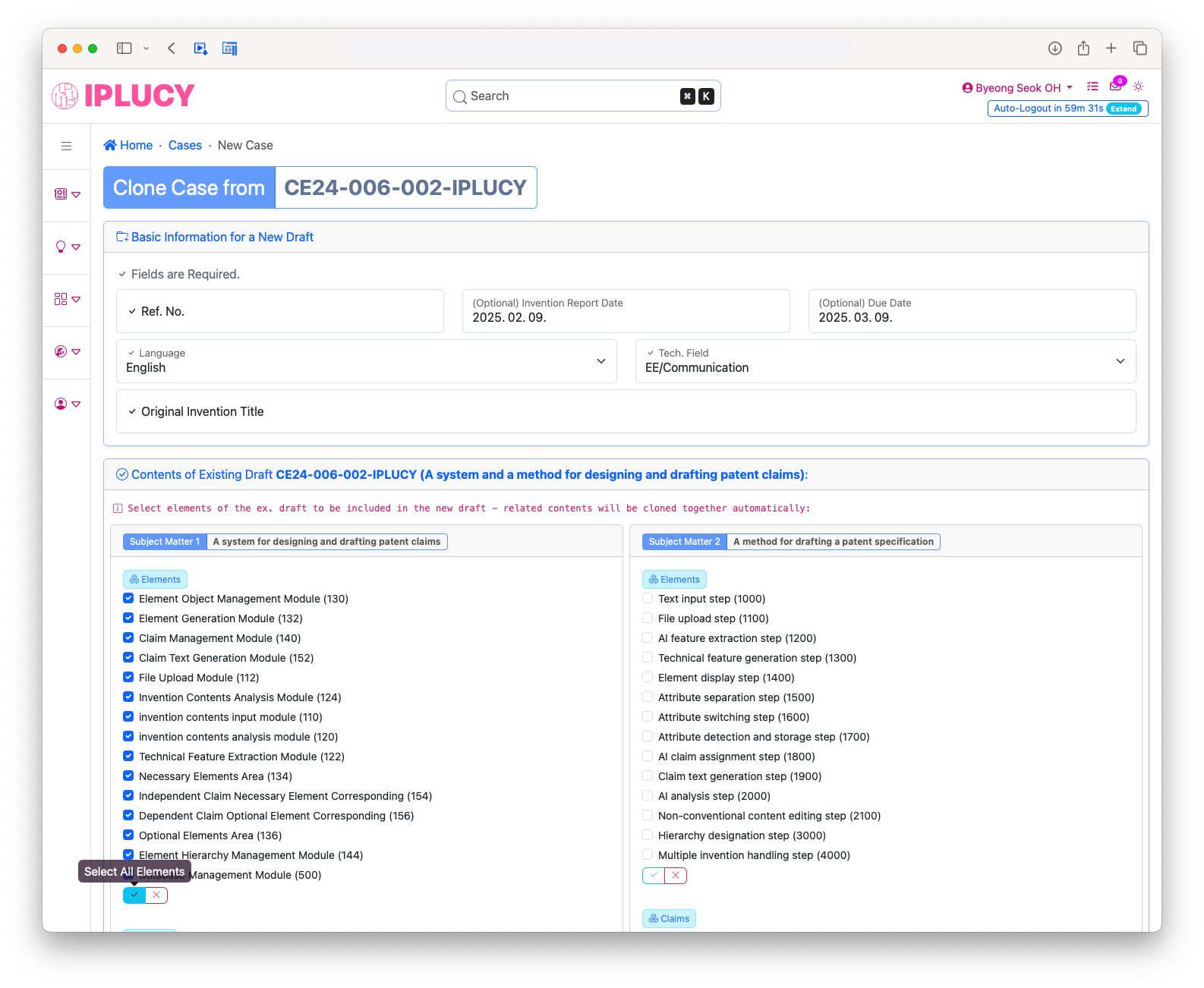Brief Introduction to IPLUCY SpecEngine™
- Analyze invention disclosures (coming soon)
- Design patent right scopes and claims structures
- Generate block diagrams and/or flowcharts automatically
- Generate texts of detailed descriptions corresponding to claims and drawings
How it Works
Step 1. Create a New Case Click to Open/Close
Create a New Case
Selecting "Create Draft" from the menu icons on the left side of the screen will take you to a screen where you can create a new case. Fill in the required fields with your data and click the "Create" button below to create a new case and be taken to the case information screen.
Create a New Case Screen
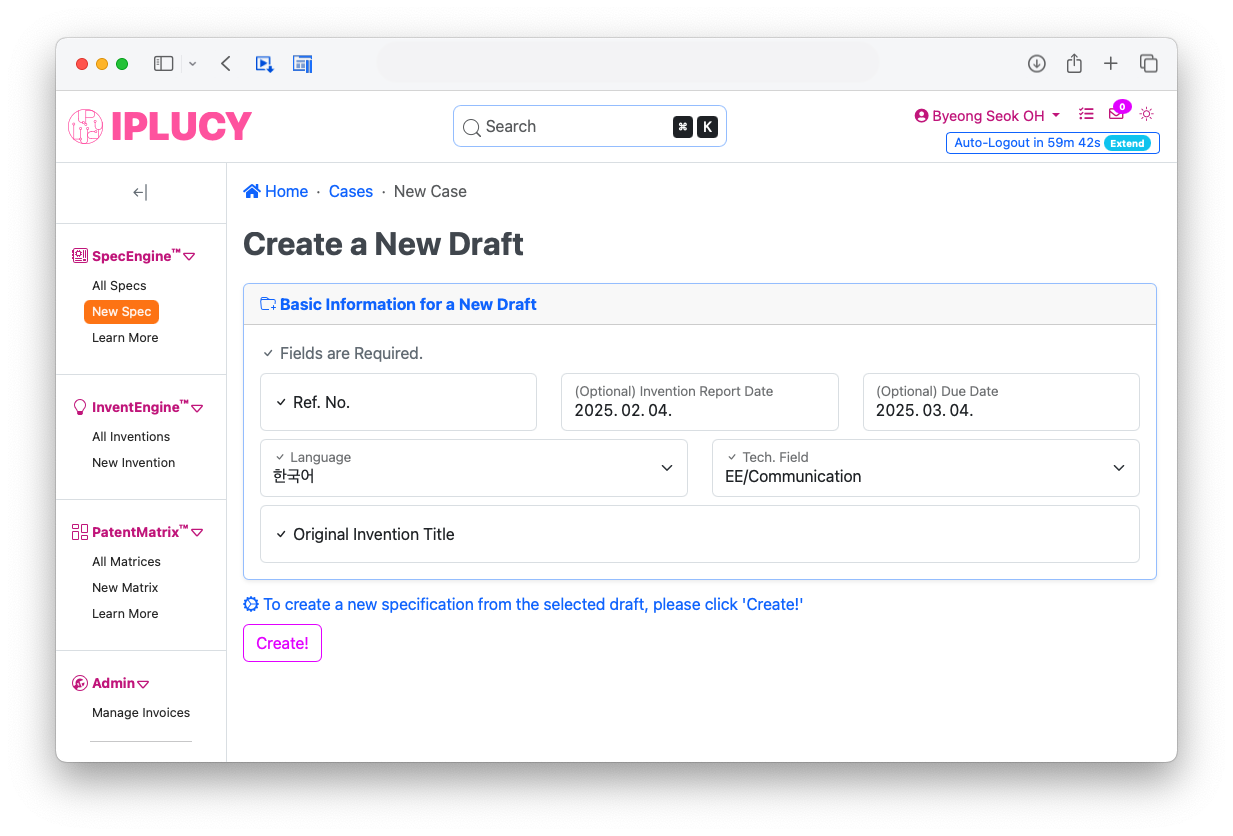
Created Case Info.
Created Case Info. Screen
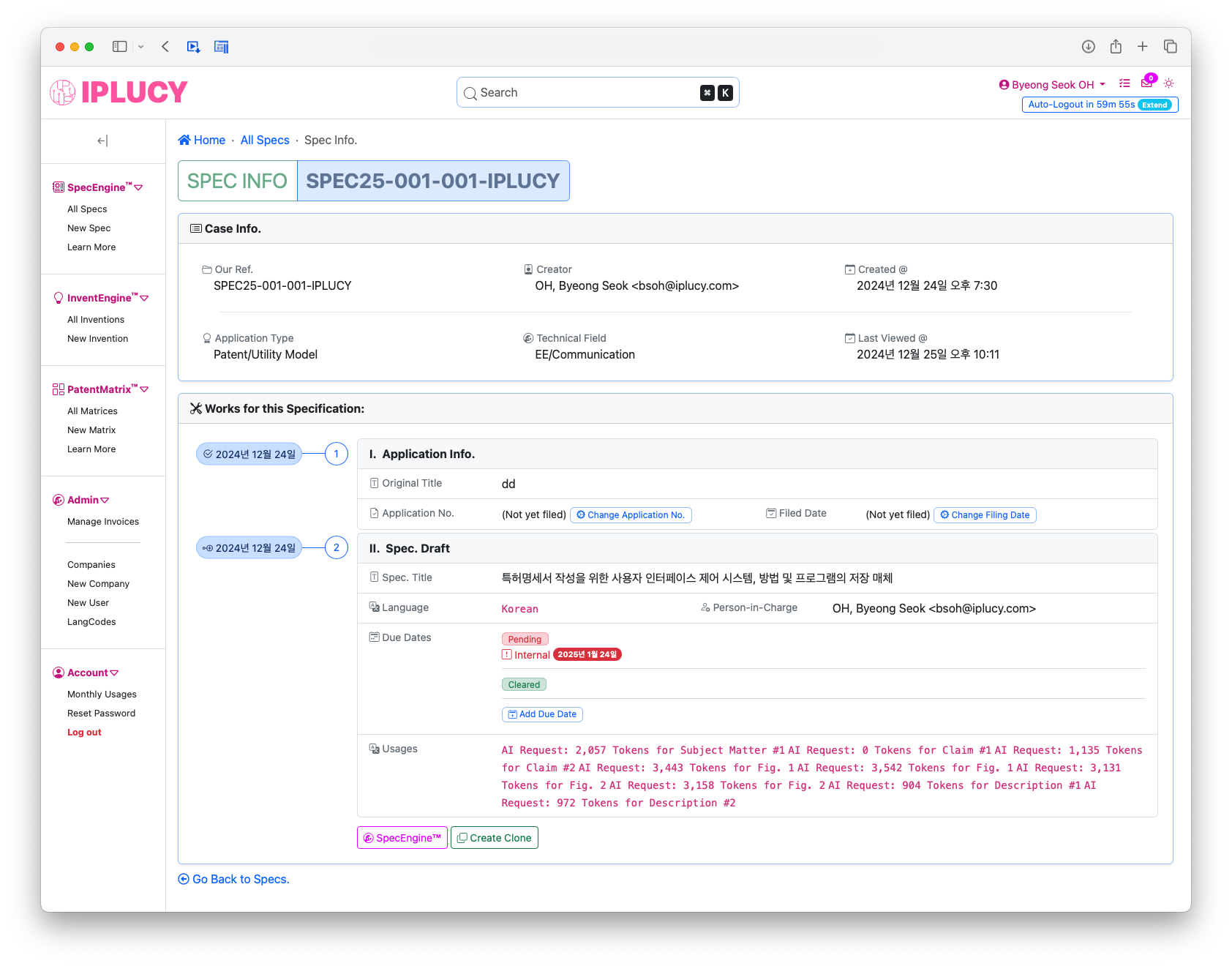
Clicking the "SpecEngine™" button at the bottom of the screen will take you to a screen where you can design the patent claims for this case.
Step 2. Define Subject Matter Click to Open/Close
Define Subject Matter
First, input proper title of the invention. This title is used for generating contents of the whole specification.
Then, select a category for the Subject Matter of the invention and enter a name for it. The category and name of the Subject Matter will be used to generate the draft texts of this subject matter.
Define Subject Matter Screen
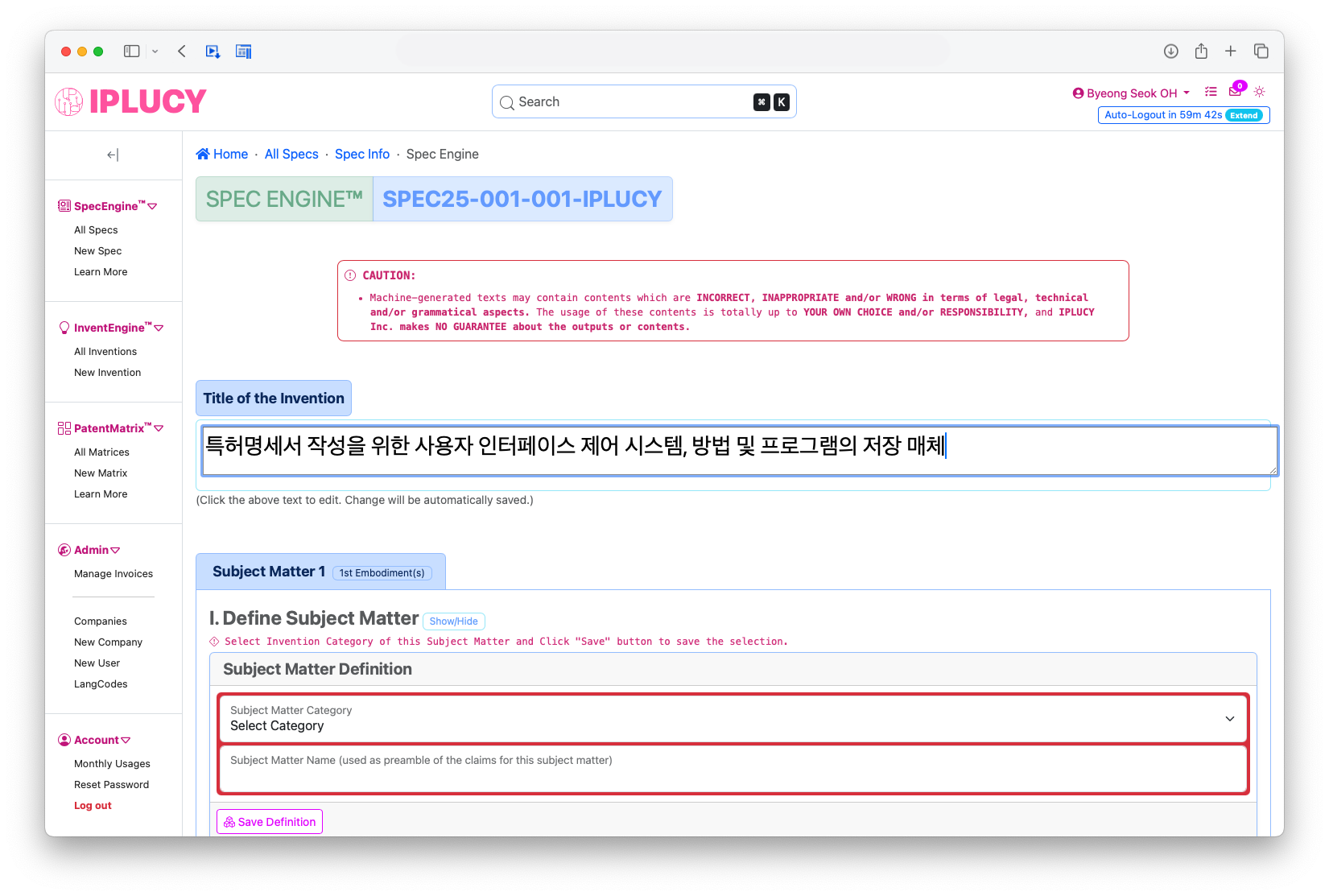
Step 3. Input Invention Disclosure Texts Click to Open/Close
Input Texts of Invention Disclosure
Click the "Invention Contents Input Area" below the icon of " Invention Content Texts" to enter texts about your invention.
Input Invention Contents Texts Screen
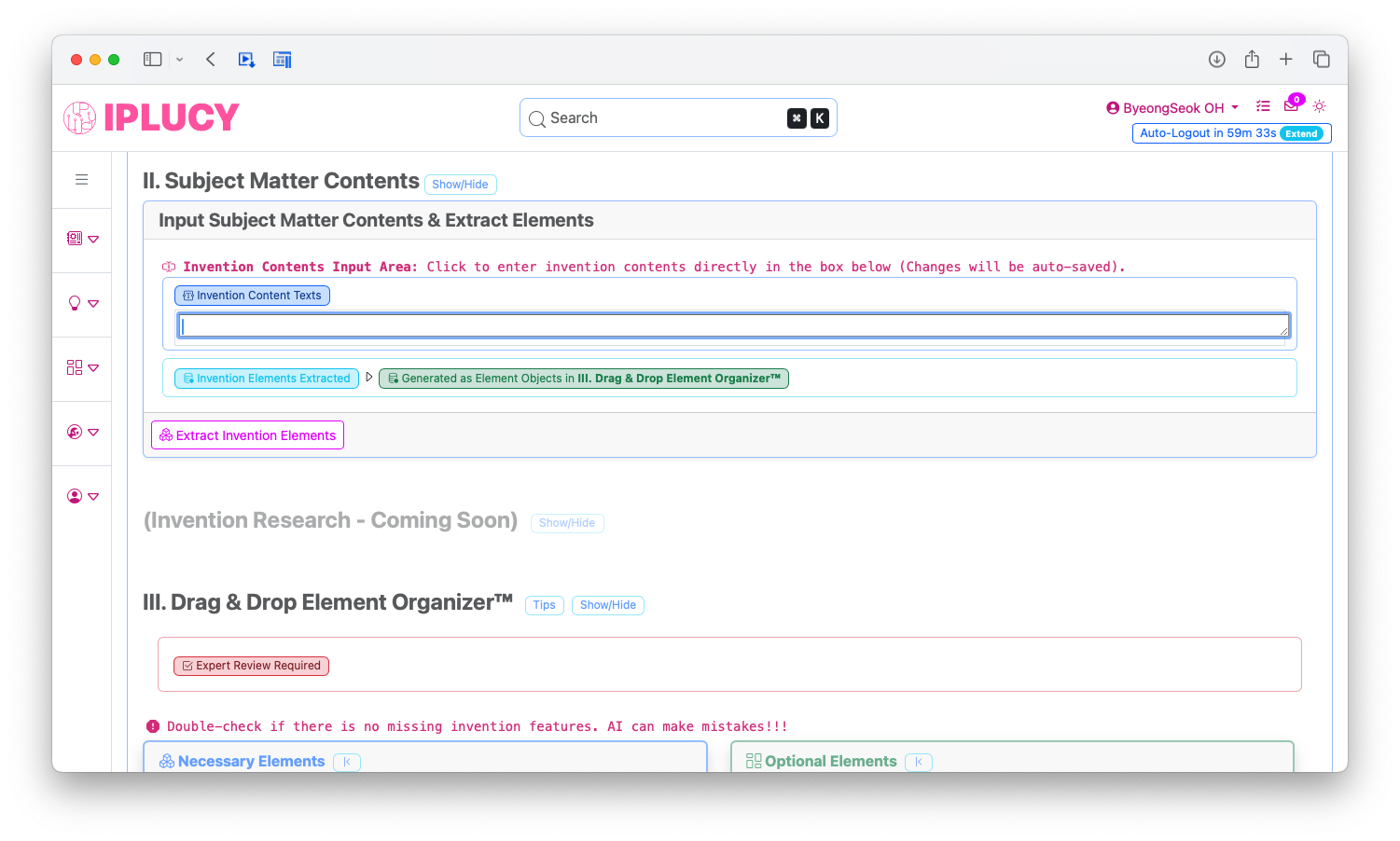
Step 3.1. Analyze Invention Disclosure (Coming Soon) Click to Open/Close
Step 4. Extract Features and Elements Click to Open/Close
Extract Technical Features and Elements of the Subject Matter
Once inputting invention contents is completed, click the " Extract Features and Elements" button below to proceed to the next step for extracting technical features and elements from the invention contents.
Extract Features and Elements Button Screen
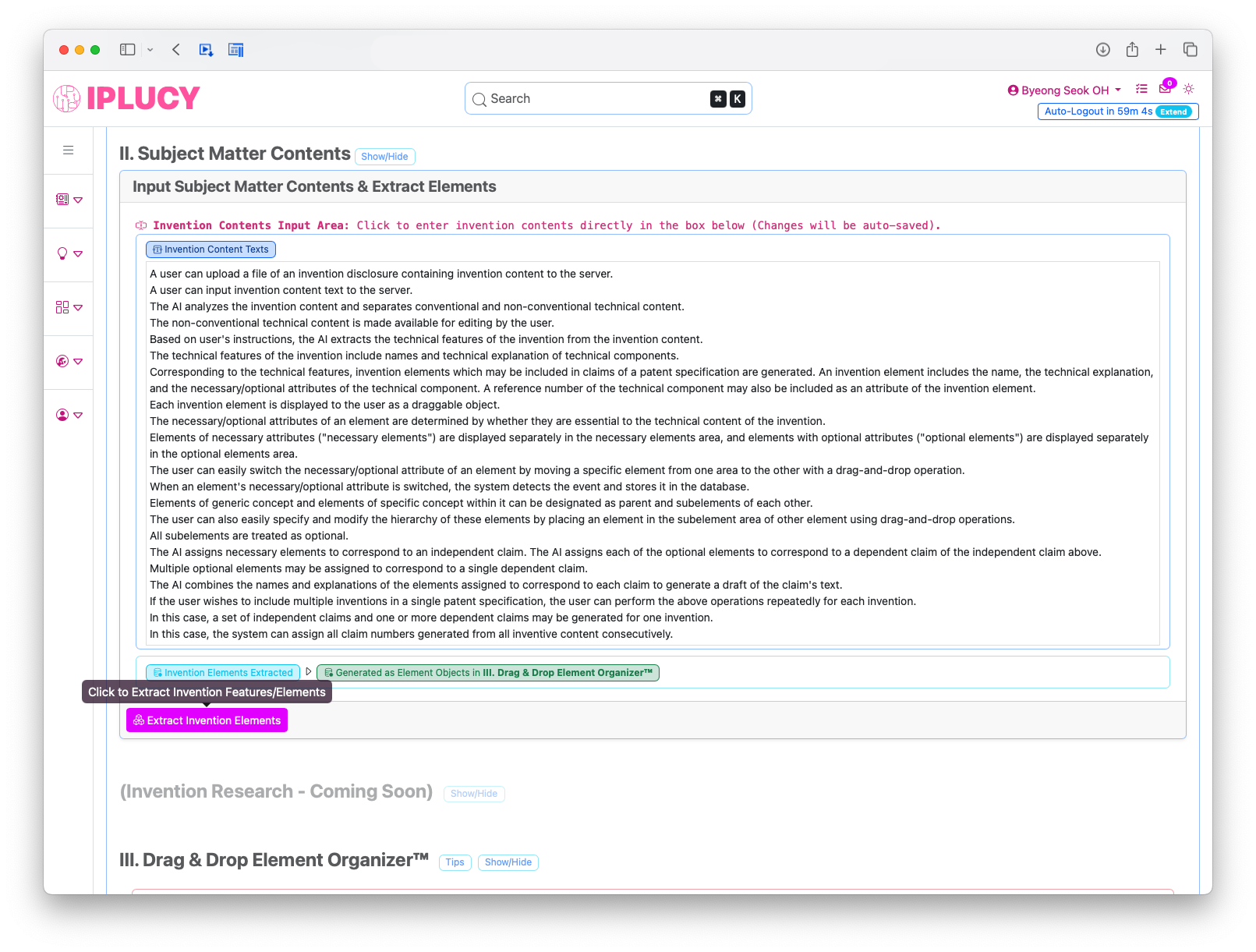
Extracted Features and Elements
Based on the texts in the "Invention Contents Input Area", the AI extracts technical features contained in the invention contents and generates corresponding invention elements.
The technical features of the invention are the technical components that make up the invention technology, and the invention elements are objects having contents to be included in the patent claims. Each element includes a reference number (if any), a name, a technical description (shown in "Limitation(s)") and sub-elements (shown in "Sub-Elements" area).
SpecEngine™ makes it easy to visually design and modify a hierarchical structure of patent claims by providing convenient drag-and-drop operations of the invention elements, as described further in Step 5.
Extracted Features and Elements Screen
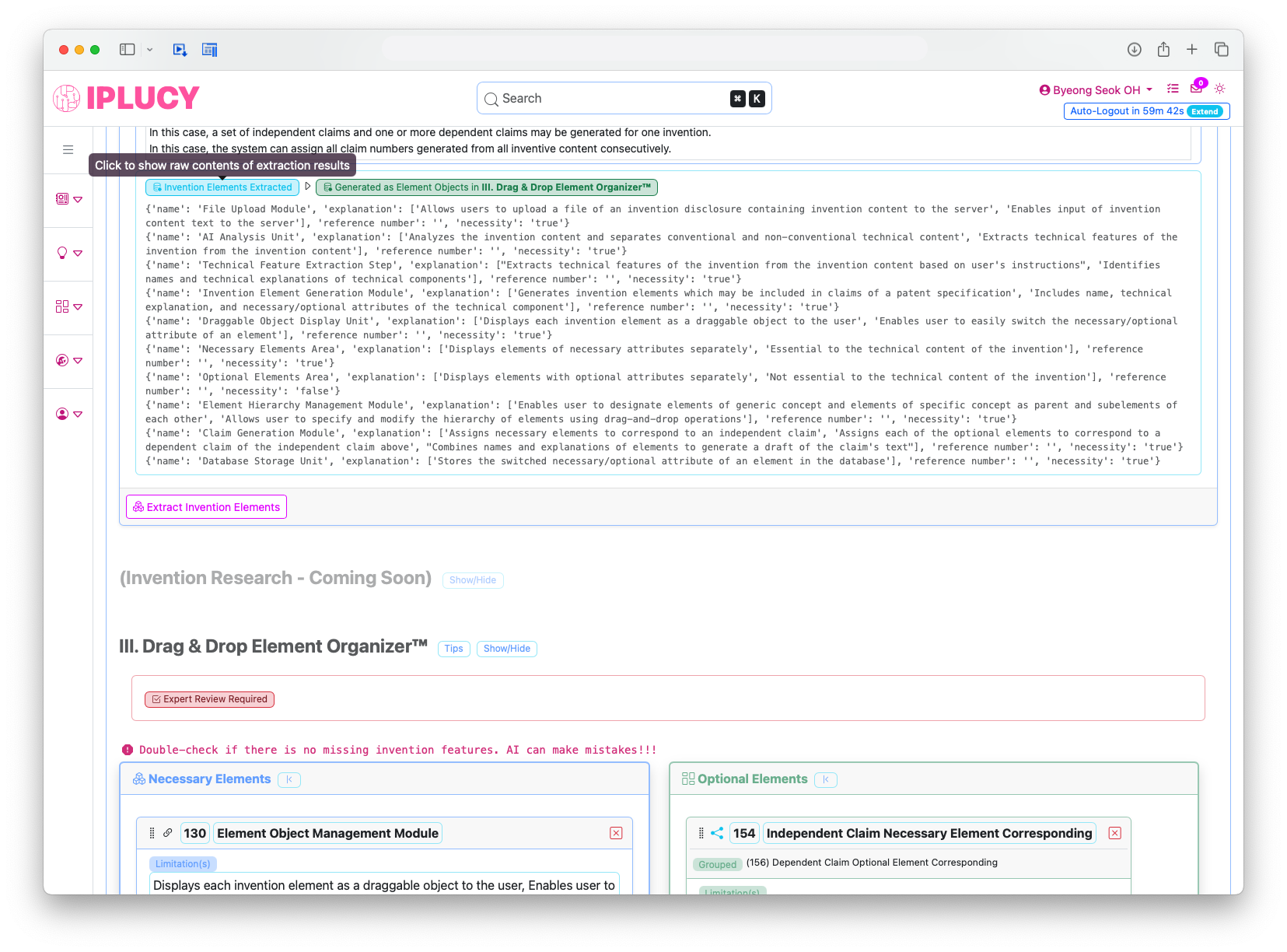
Add or Delete Invention Elements
Danger!!!The invention elements generated by AI may be missing from the original invention, or may include unnecessary contents. The invention elements are what generate patent claims, so be sure to double-check them and add any missing elements or correct any errors.
Add/Delete Invention Element Screen
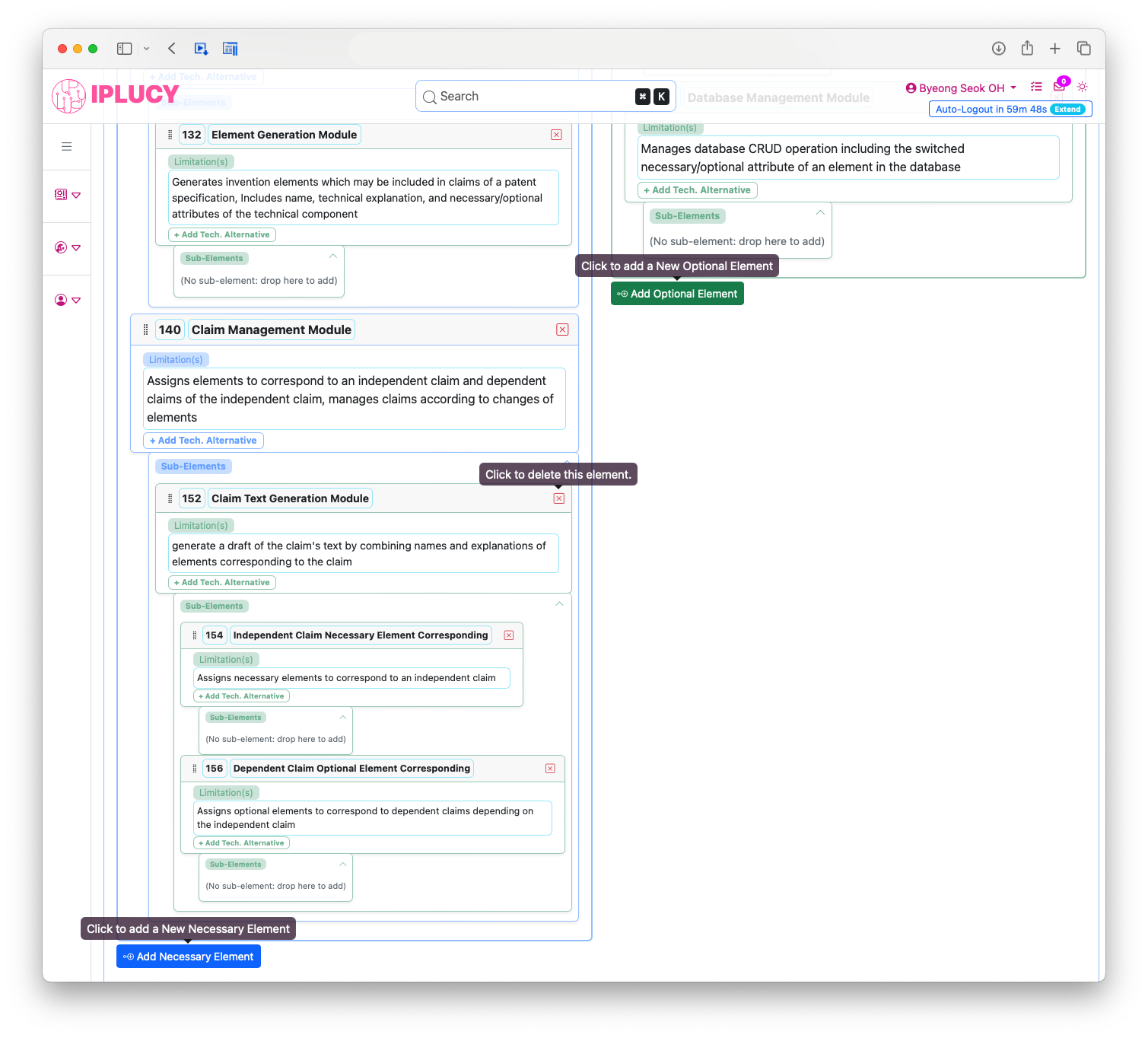
Clone Invention Element
You can quickly add components with similar content by cloning an invention element created by AI. Click the "" icon of the desired element object to open a dialog box where you can enter the contents of the new element.
Cloning invention element icon screen
Correct the content as needed and click the 'confirm' button to add a new invention element object.
Cloning invention element dialog screen
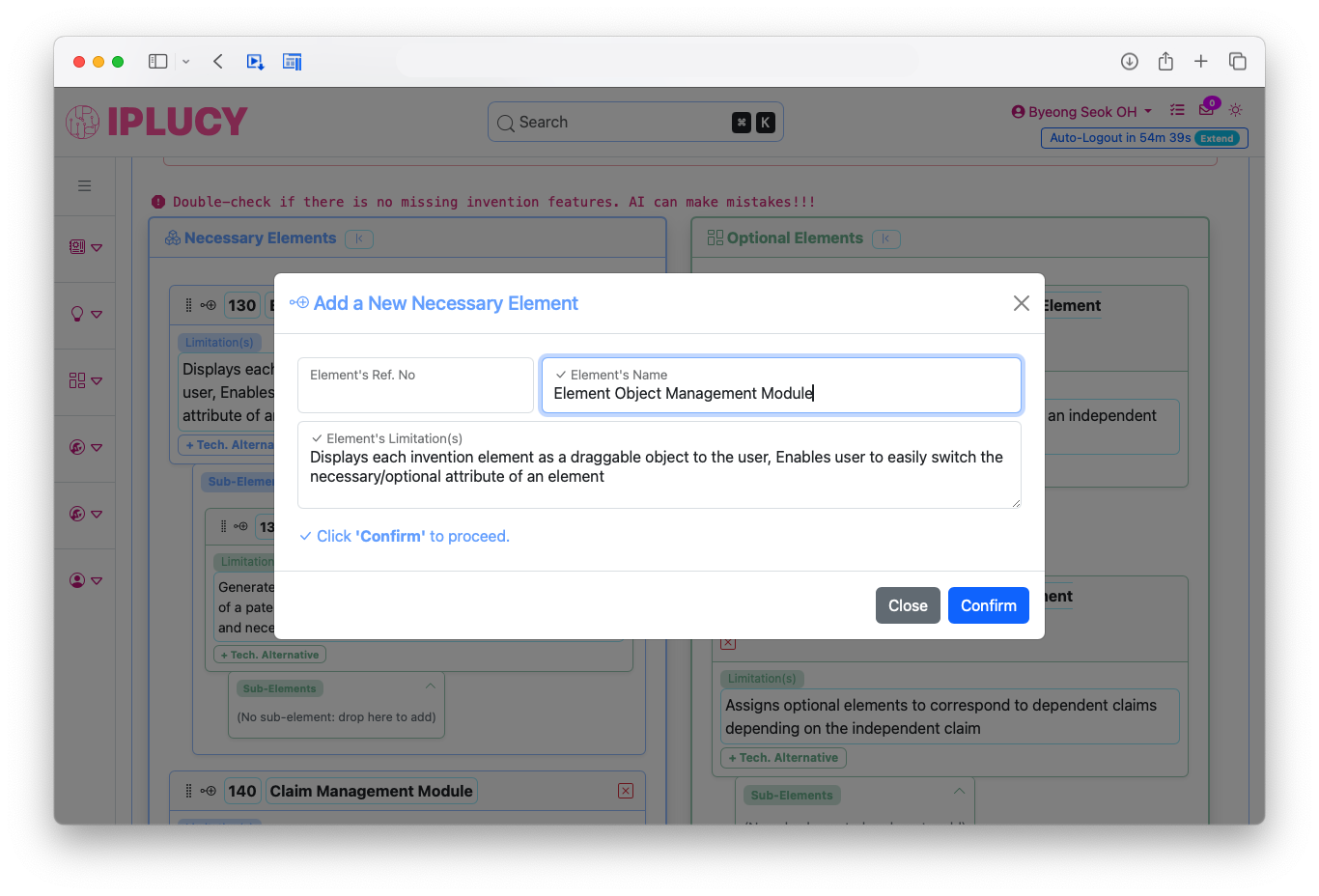
Step 5. Design Elements Hierarchy Click to Open/Close
Claims Design Principles
Patent claims must provide broad and solid protection for the various aspects of an invention. To accomplish this, IPLUCY's patent attorneys have established several principles through decades of patent practices, including:
- Independent Claim: Include only the minimum technical elements that are indispensable to the invention technology.
- Dependent Claim: Include technical elements that are desirable when added to the invention technology.
- Hierarchy Relationship 1: Each technical element is expressed in the terms of generic concept in its broadest sense.
- Hierarchy Relationship 2: Each technical element of a higher-level concept can be embodied by technical elements of as many lower-level concepts as possible.
Manipulate Invention Elements
The most important feature of SpecEngine™ is the ability to change the properties of invention elements, which is often done for the above claim design principles, with drag-and-drop operations.
By dragging each element's "" icon, you can switch its necessity attribute (necessary to optional, vice versa) or make it a sub-element of another element. These visual operations not only help make the work easier, but they also help you avoid mistakes and correct errors.
This step is crucial to designing solid patent claims. Take your time and carefully review all the elements to ensure that they are perfect.
Manipulate Invention Elements Screen
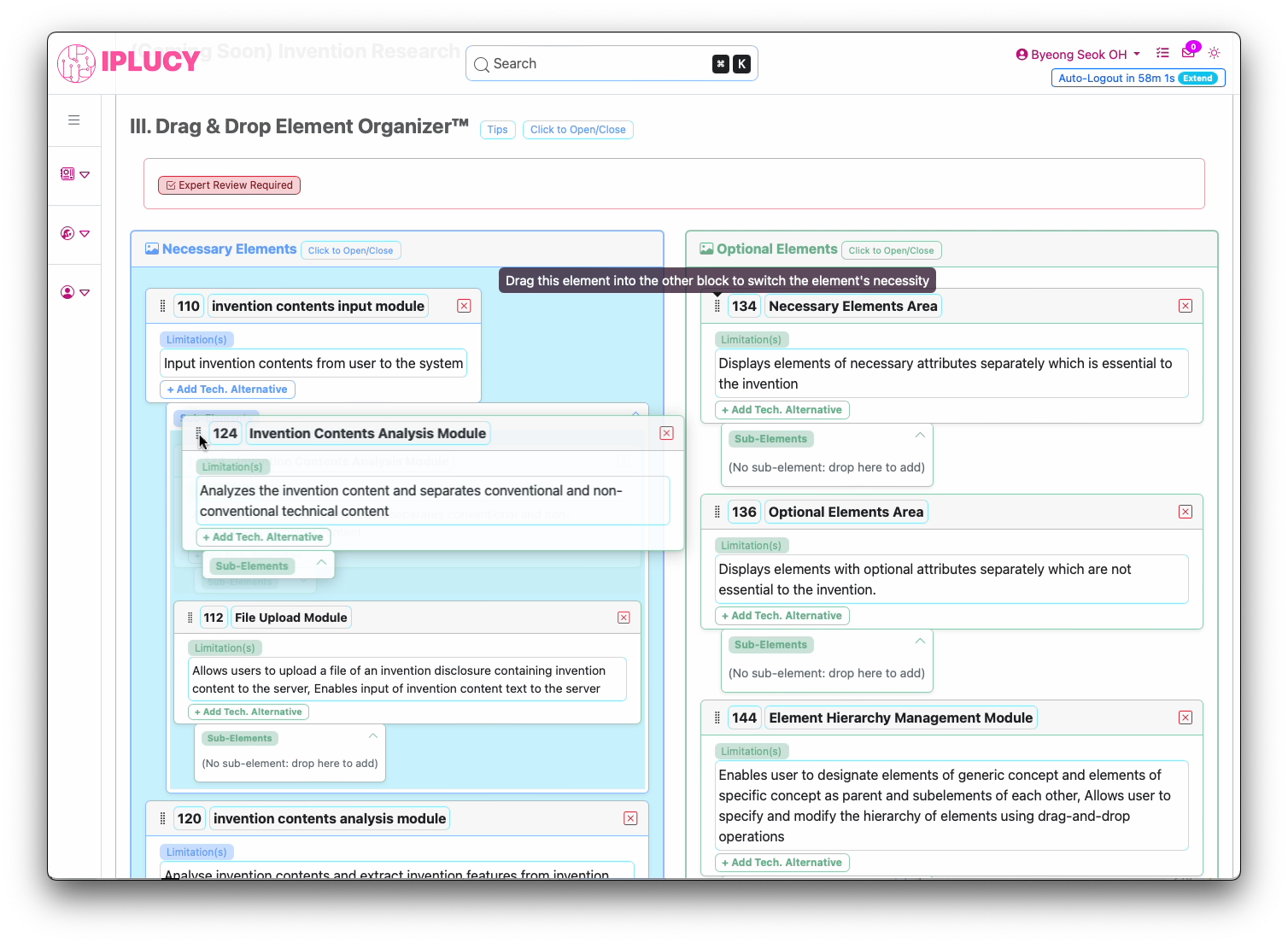
Step 6. Build Claims and Generate Claim Texts Click to Open/Close
Build Claims
Once all elements are well organized, click the "Re/Build Claims" button in the "IV. Draft Claims, Drawings & Descriptions for Subject Matter #1" section to build patent claims corresponding to the invention elements.
An independent claim is built based on the necessary elements only, and dependent claims are built based on each optional element or each element's technical alternatives or sub-elements (if any). The claims that the dependent claims are dependent upon are automatically designated based on their corresponding elements' hierarchy.
Build Claims Screen
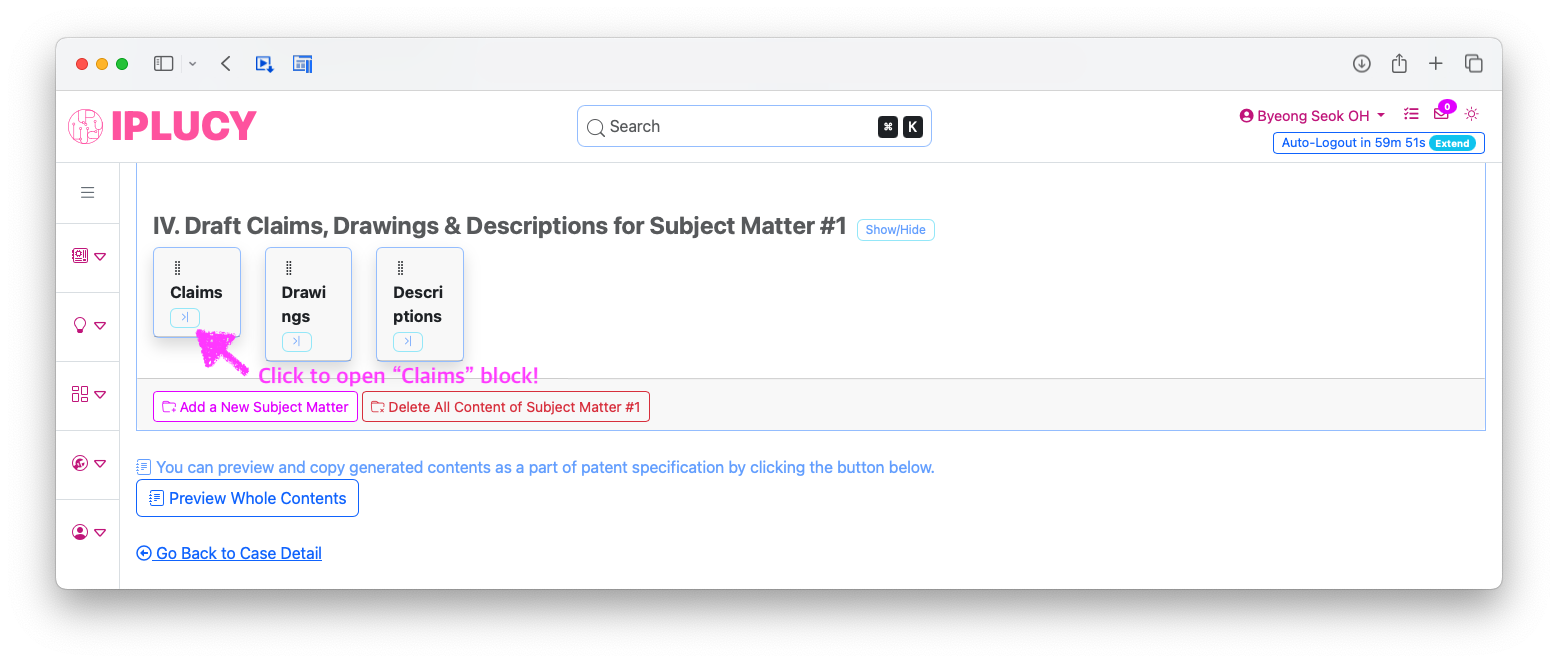
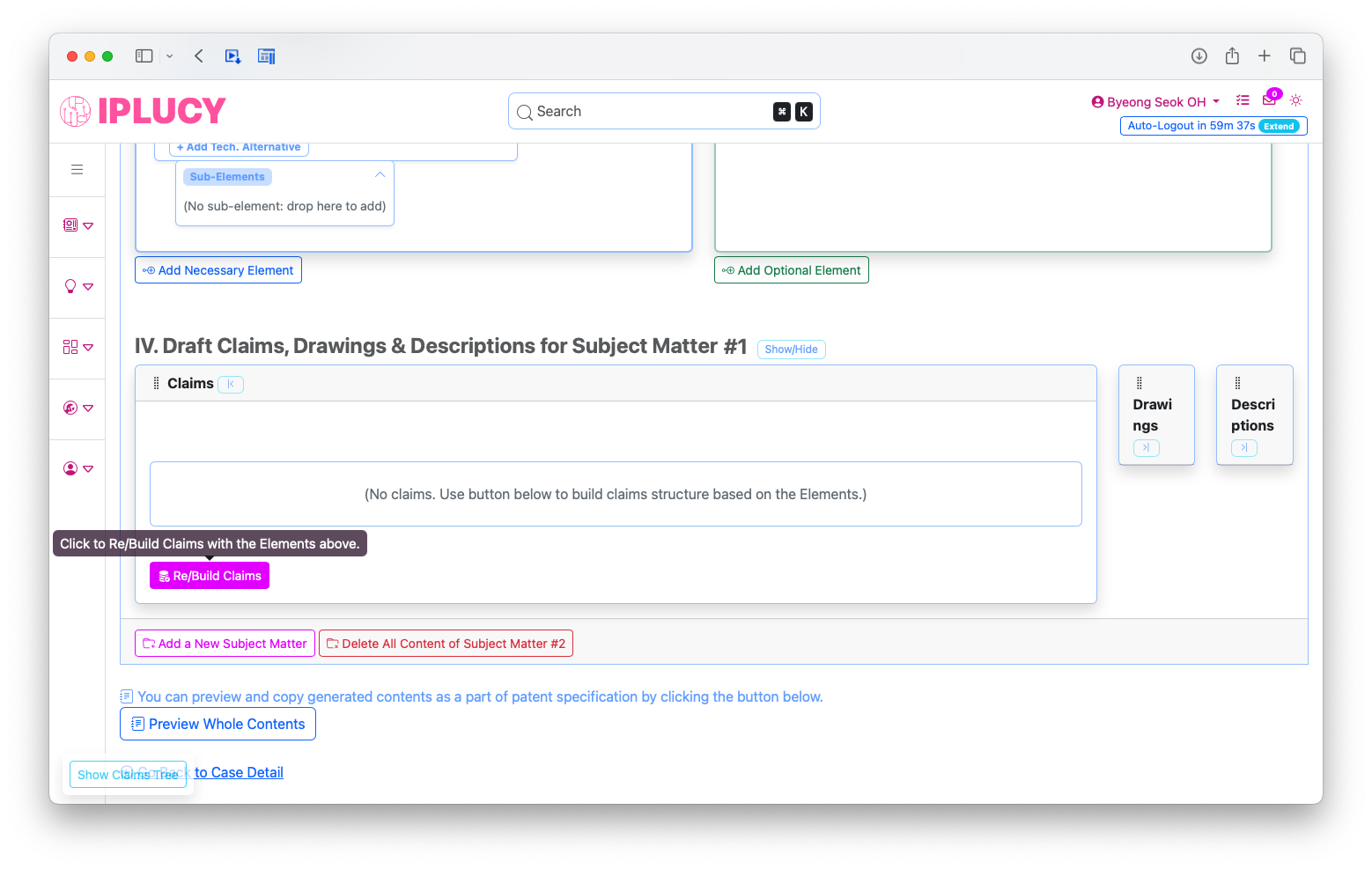
Claims Tree
Danger!!!To help you understand the citation relationships of the generated claims at a glance, click the "Show Claims Tree" button in the lower left corner of the screen, which will display the "Claims Tree for Subject Matter #(subject matter no.)" area on the right side of the screen. Click the button again and the tree area will disappear.
Claims Tree Screen
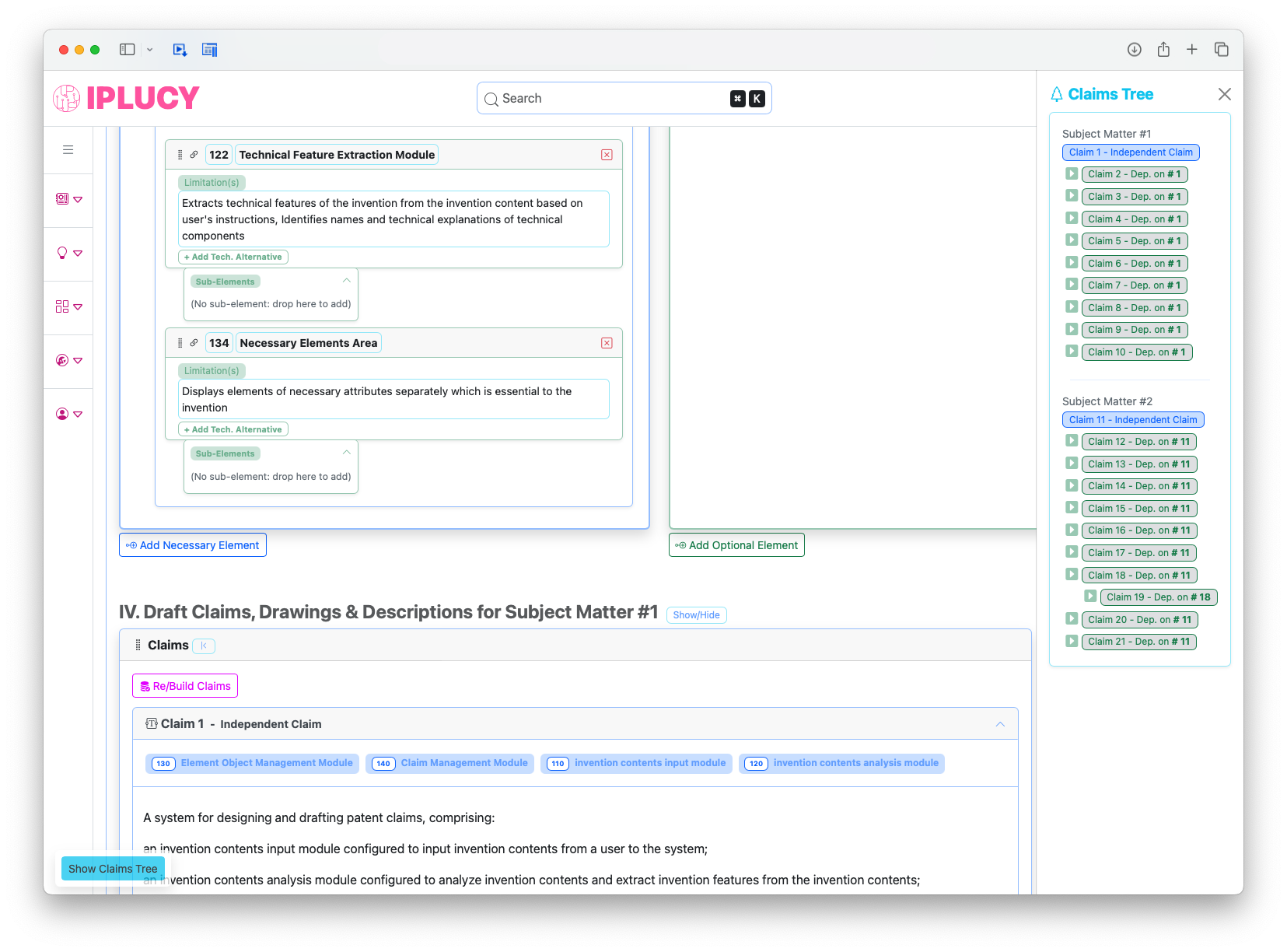
Generate Claims Texts
Danger!!!Review the built claims for correct correspondence and citation relationships, and if there are no issues, click " Get AI Text for Claim #(claim no.)" button at the bottom of each claim to generate texts for each claim.
The AI will combine the descriptions and names of the corresponding elements to generate the best-formatted claim text possible, but human expert's review and correction is essential.
Generate Independent Claim Text Screen
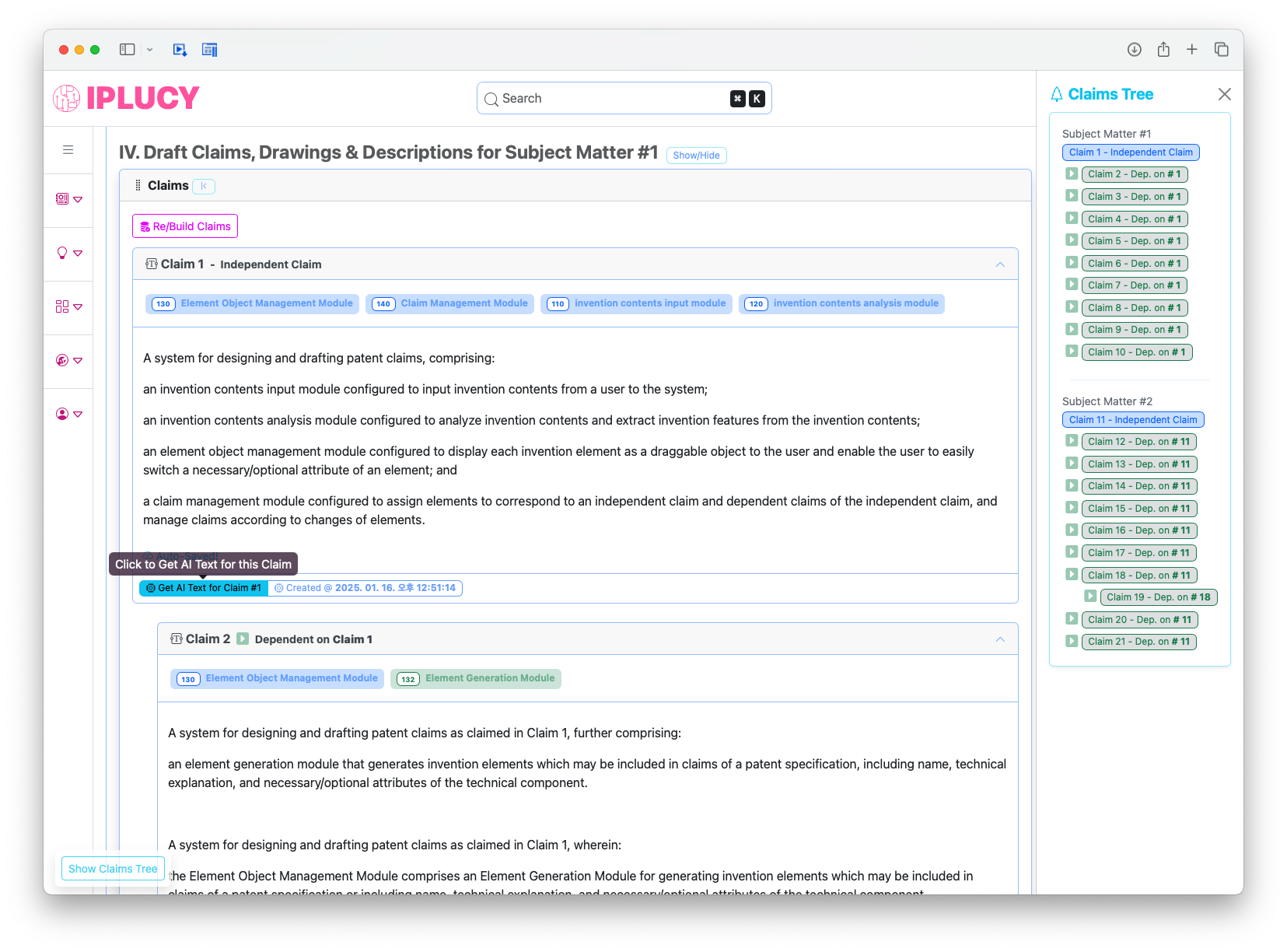
Generate Dependent Claim Text Screen
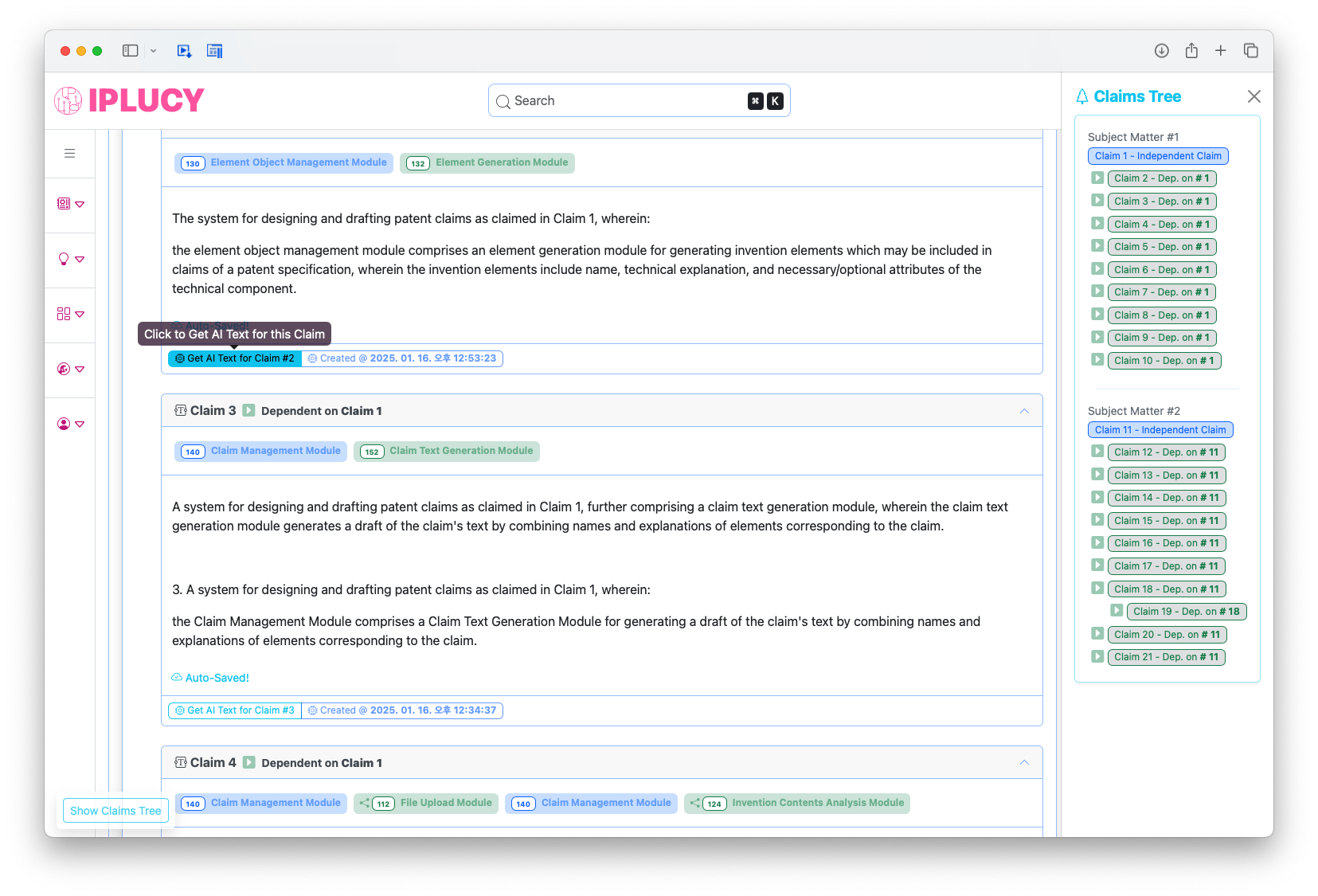
Rebuild Claims
When you added, removed and/or modified the elements by editing their texts, hierarchy, etc., you need to reorganize the claims. By clicking the "Rebuild Claims Structure" button will "rebuild" the claims according to the modified elements and their hierarchy. All the same rules explained above will be applied when rebuilding the claims.
Rebuild Claims Screen
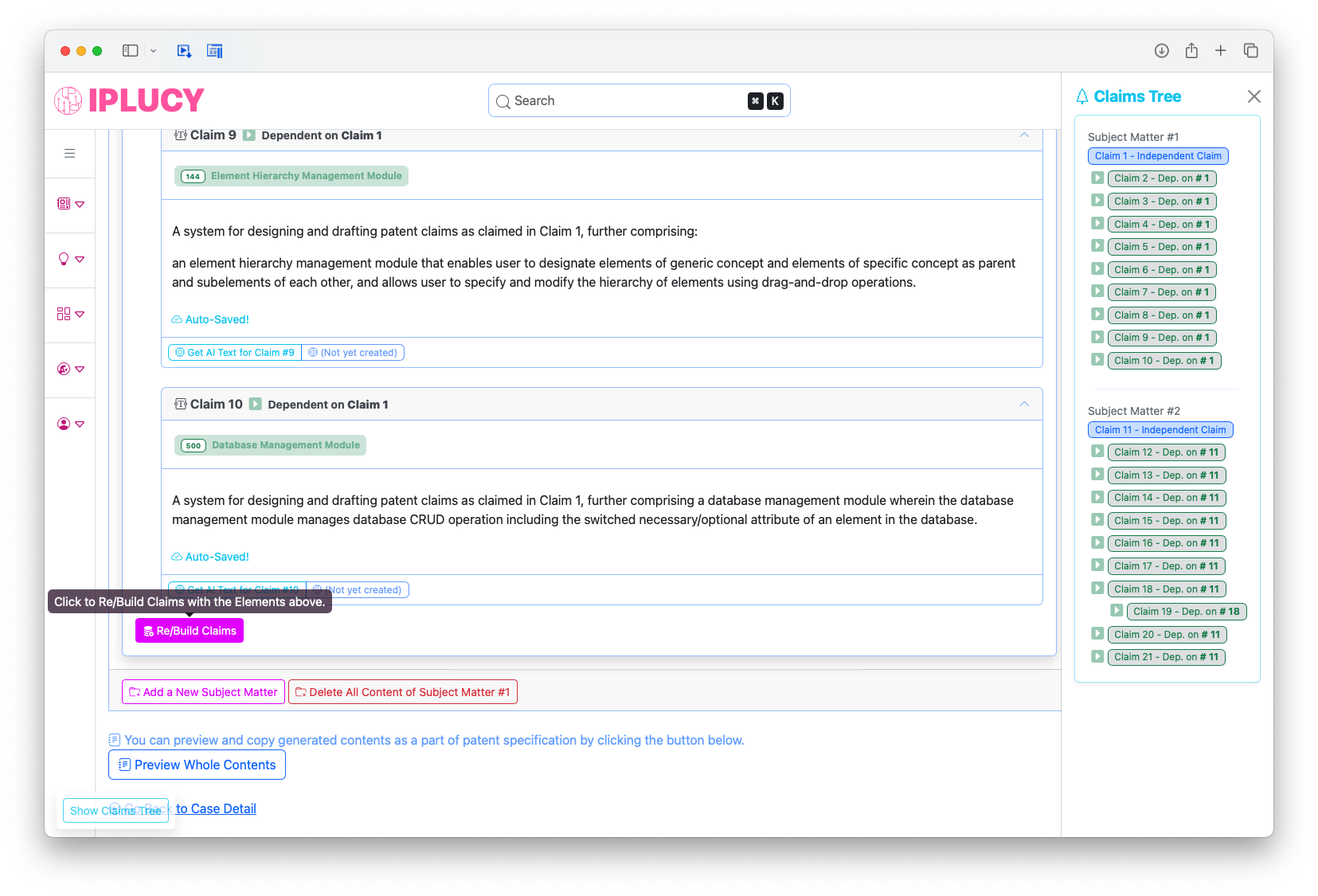
Step 7. Build Drawings Click to Open/Close
Build Drawings
Once all elements and claims are well organized, click the "Build Drawing" button in the "IV. Draft of Claims for Subject Matter" section to build drawings corresponding to the elements and their corresponding claims. Simple block diagrams, flowcharts will be automatically generated based on the contents of the subject matters, elements and claims.
Build Drawings Screen
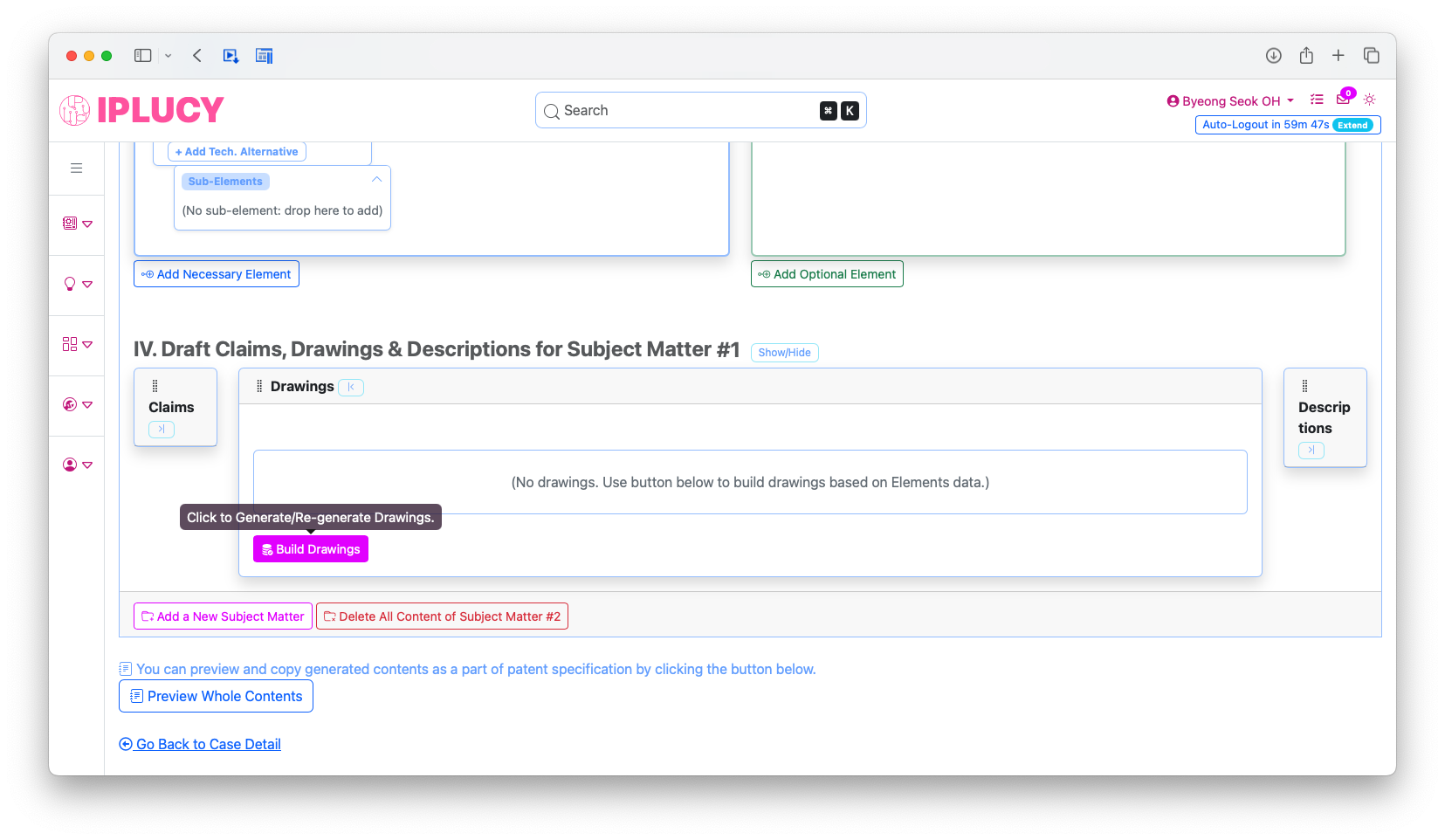
Generated Drawings
Danger!!!Review the generated drawings for correct correspondence and citation relationships, and if there are no issues.
Generated Drawings Screen
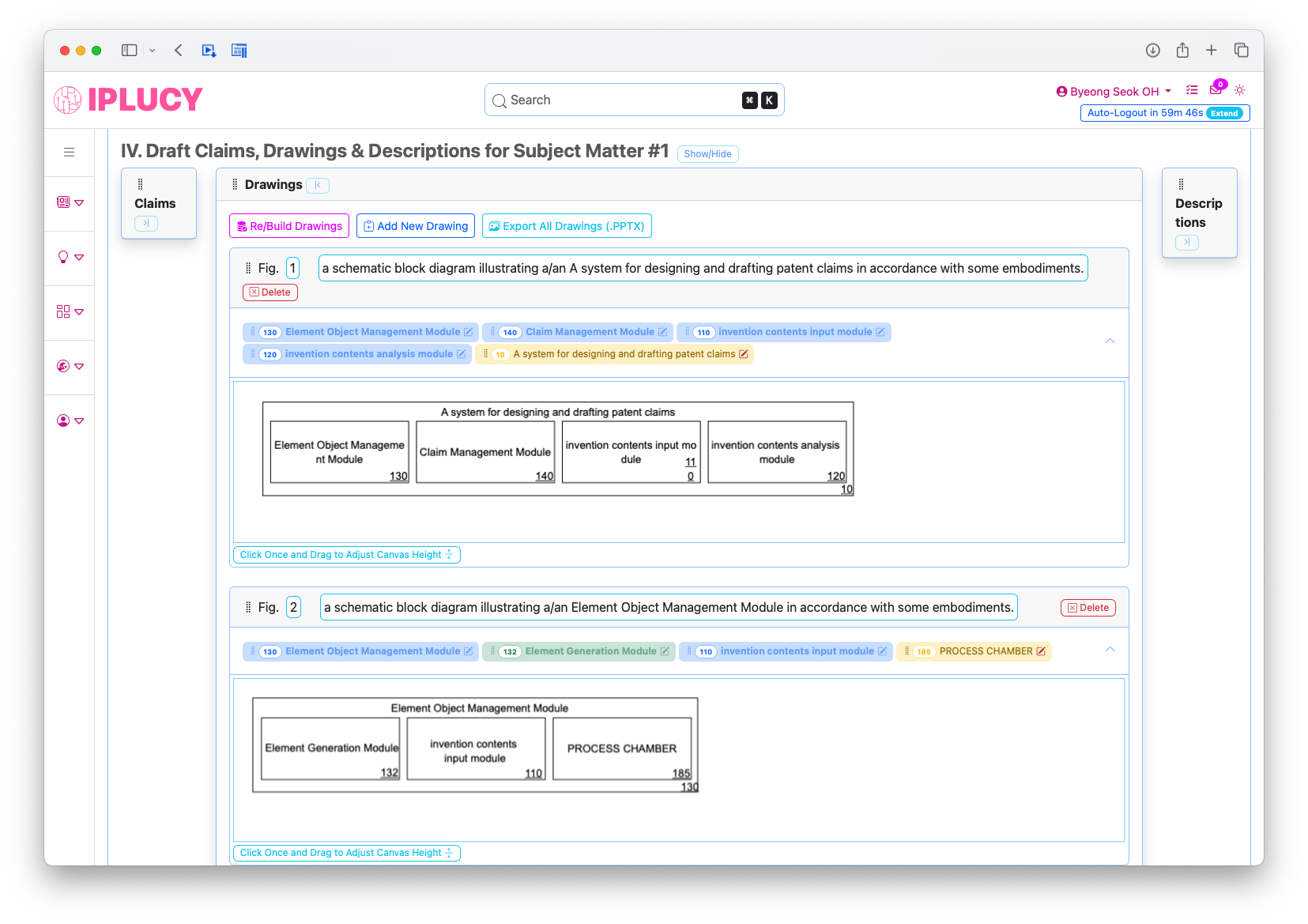
Add Custom Image to Drawing
You may want to add a customized image to a drawing sometimes. Clicking the "Add Image File to Drawing" button at the top of the drawing editor area, a dialog window will appear to guide you to add your own image file and associate text contents in the image with the drawing.
Add Image Screen
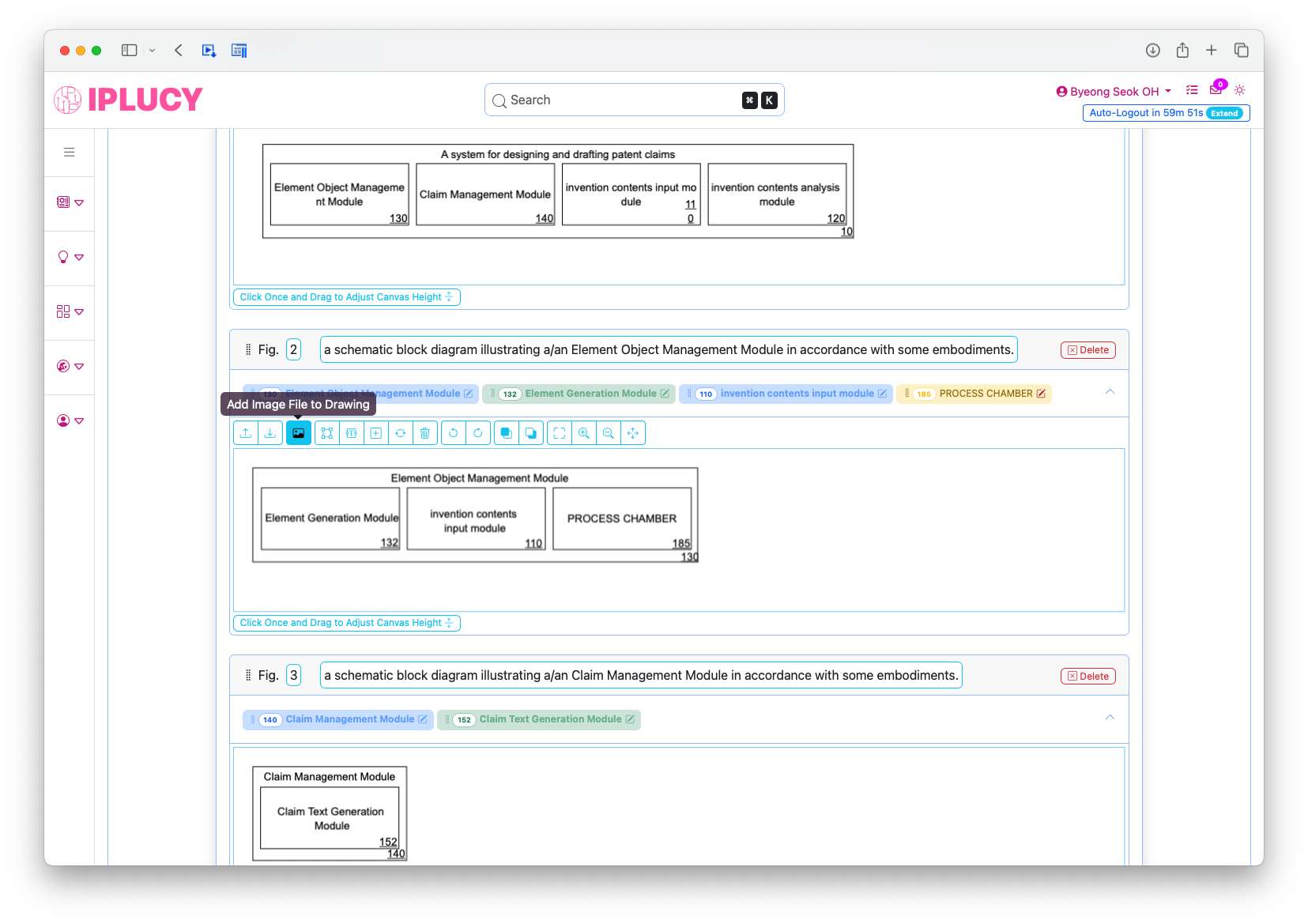
Add Image to Drawing Modal
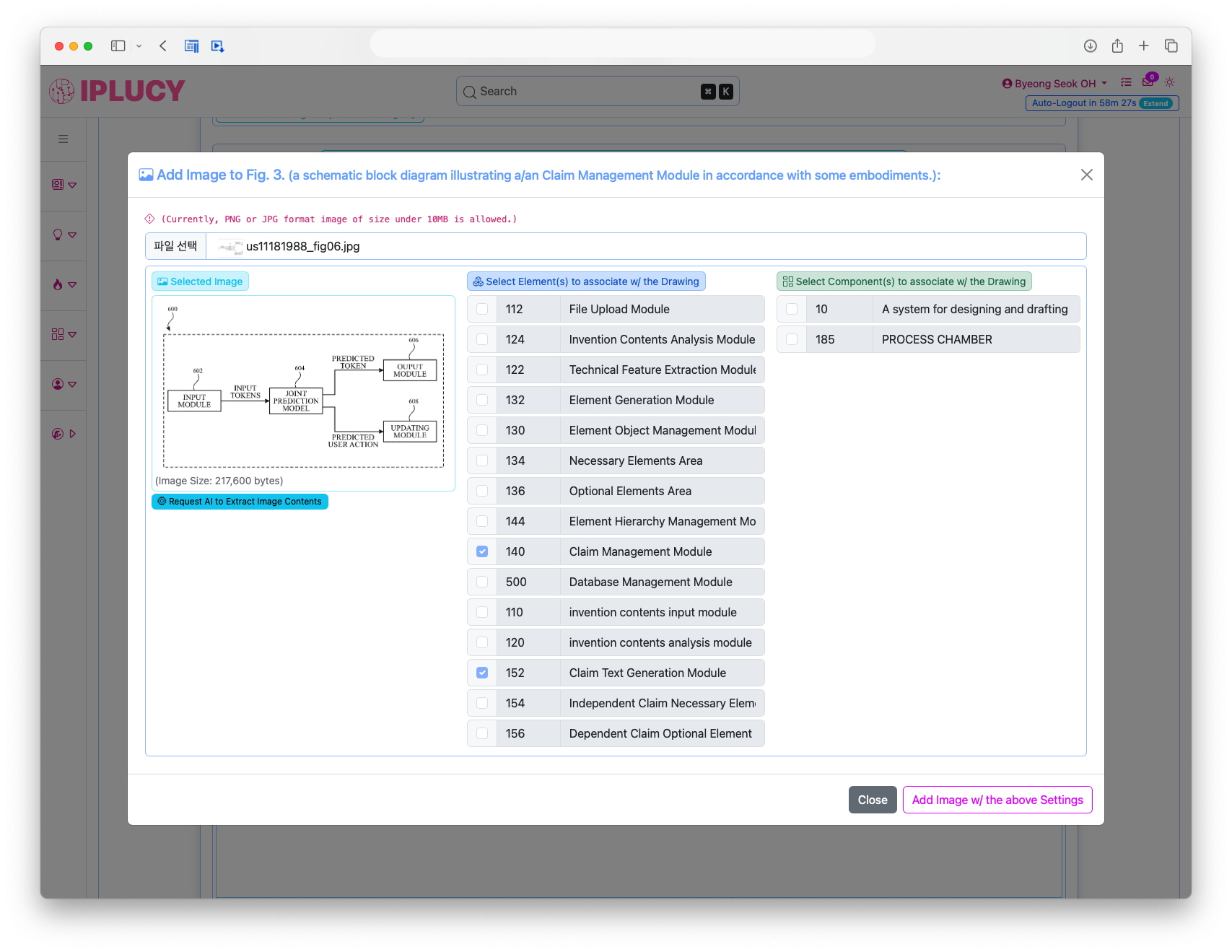
Extract Contents from Custom Image
Clicking the "Request AI to Extract Image Contents" button below the thumbnail image will send request for AI to extract all contents of the selected image file. You can get "Image Description Generated by AI" and "Image Components Extracted by AI" as responses from AI. You can save these contents for future generation of detailed descriptions for this drawing.
Extracted Image Contents Screen
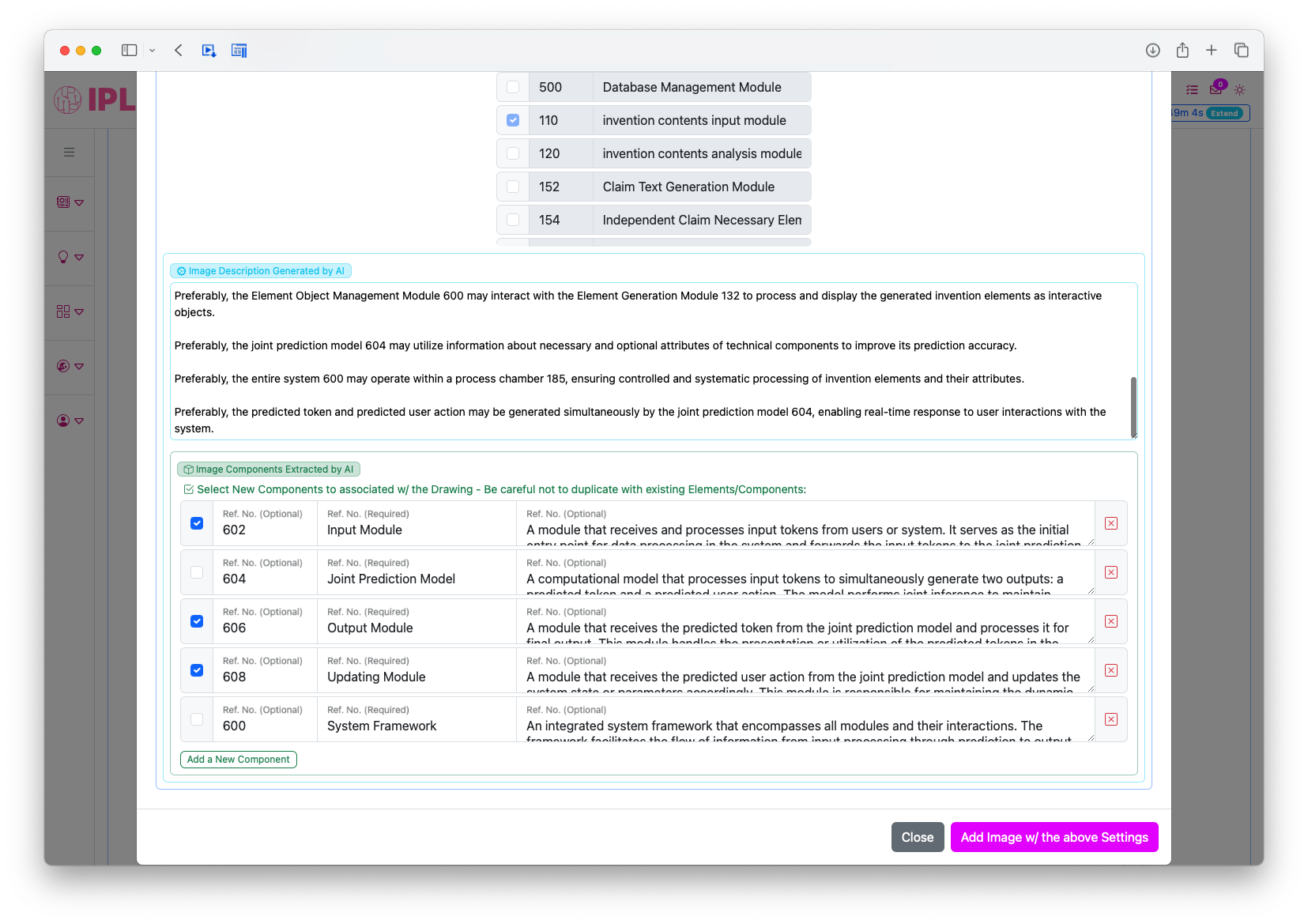
Rebuild Drawings
As in the case of "Rebuild Claims", when you added, removed and/or modified the elements by editing their texts, hierarchy, etc., you need to reorganize the drawings. By clicking the "Rebuild Drawings" button will "rebuild" the drawings according to the modified elements, claims and their hierarchy. All the same rules explained above will be applied when rebuilding the drawings.
Rebuild Drawings Screen
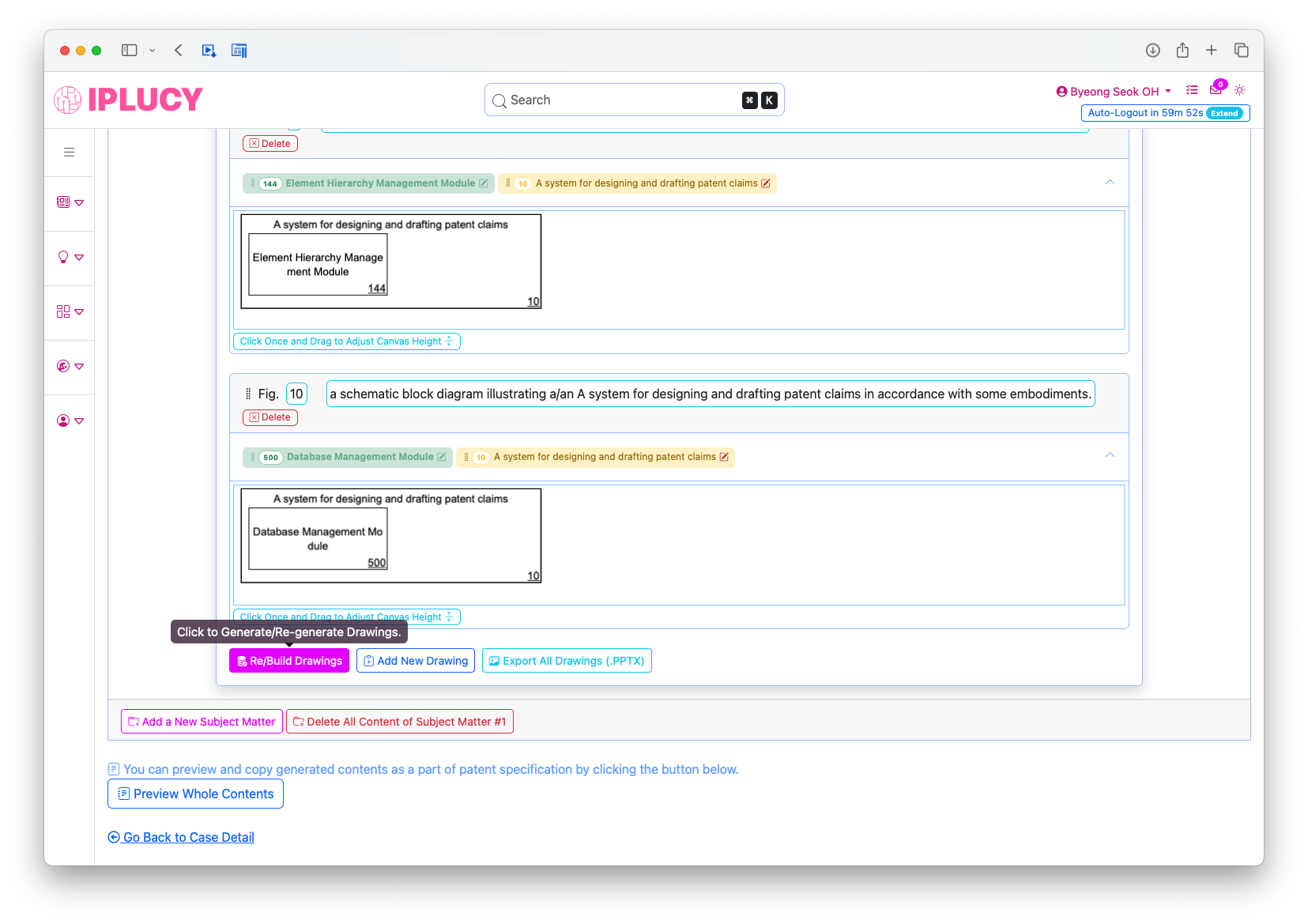
Step 8. Build Descriptions Click to Open/Close
Build Descriptions
Once all elements, claims and drawings are well organized, click the "Build Descriptions" button in the "IV. Draft of Claims for Subject Matter" section to build descriptions corresponding to the previous contents. A dialog window will appear for you to select sections to be created and associated with claims and/or drawings. You can easily control which contents will be added to the detailed descriptions using this dialog window.
Build Descriptions Screen
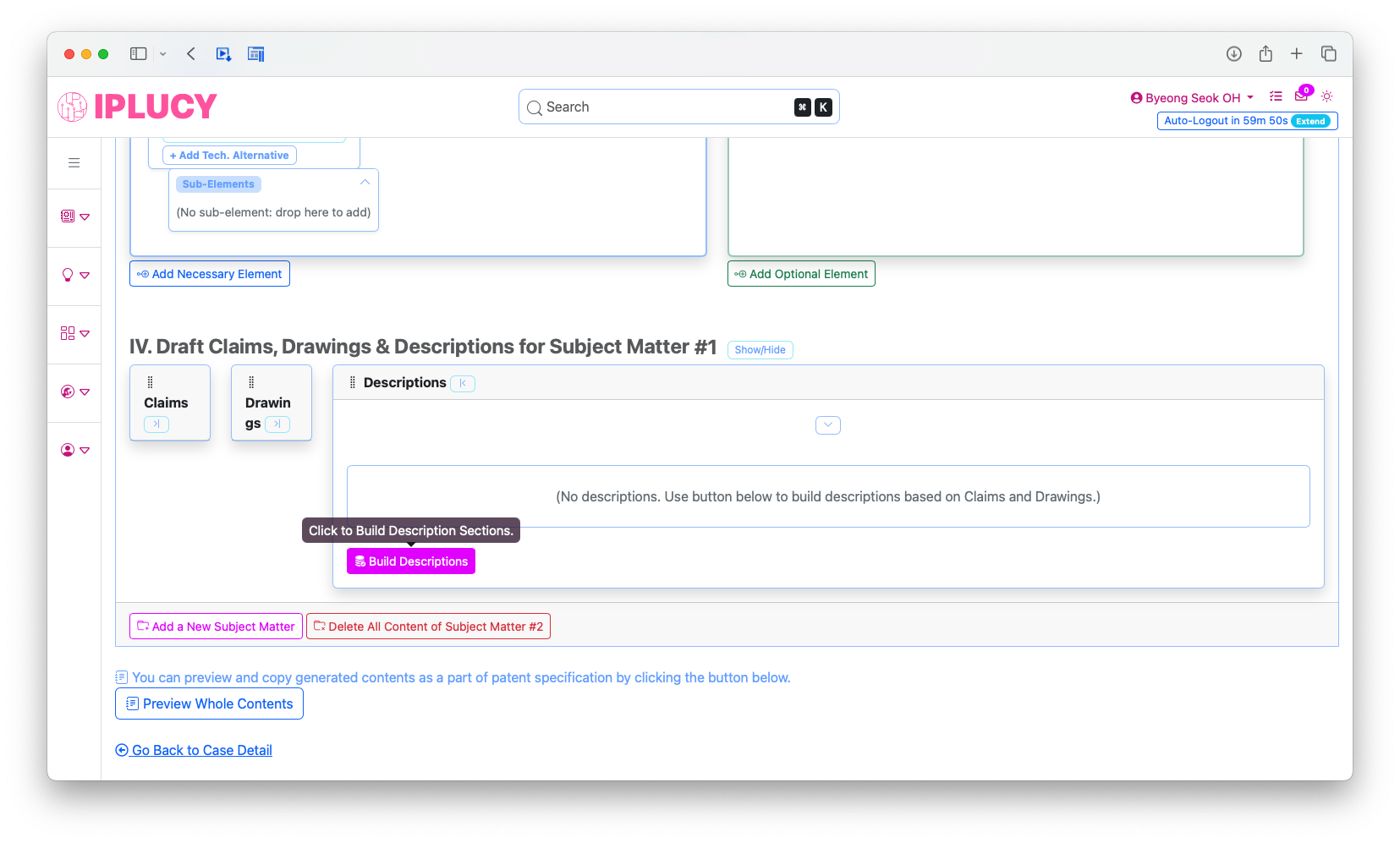
Build Descriptions Dialog Screen

Generate Description Section Texts
Danger!!!Click "Generate AI Text" button at the bottom of each description section to generate texts for each description section. The AI will extract associated data with the description section to generate the detailed description of the section. Be sure to remember human expert's review and correction is essential.
Generate Description Section Texts Screen
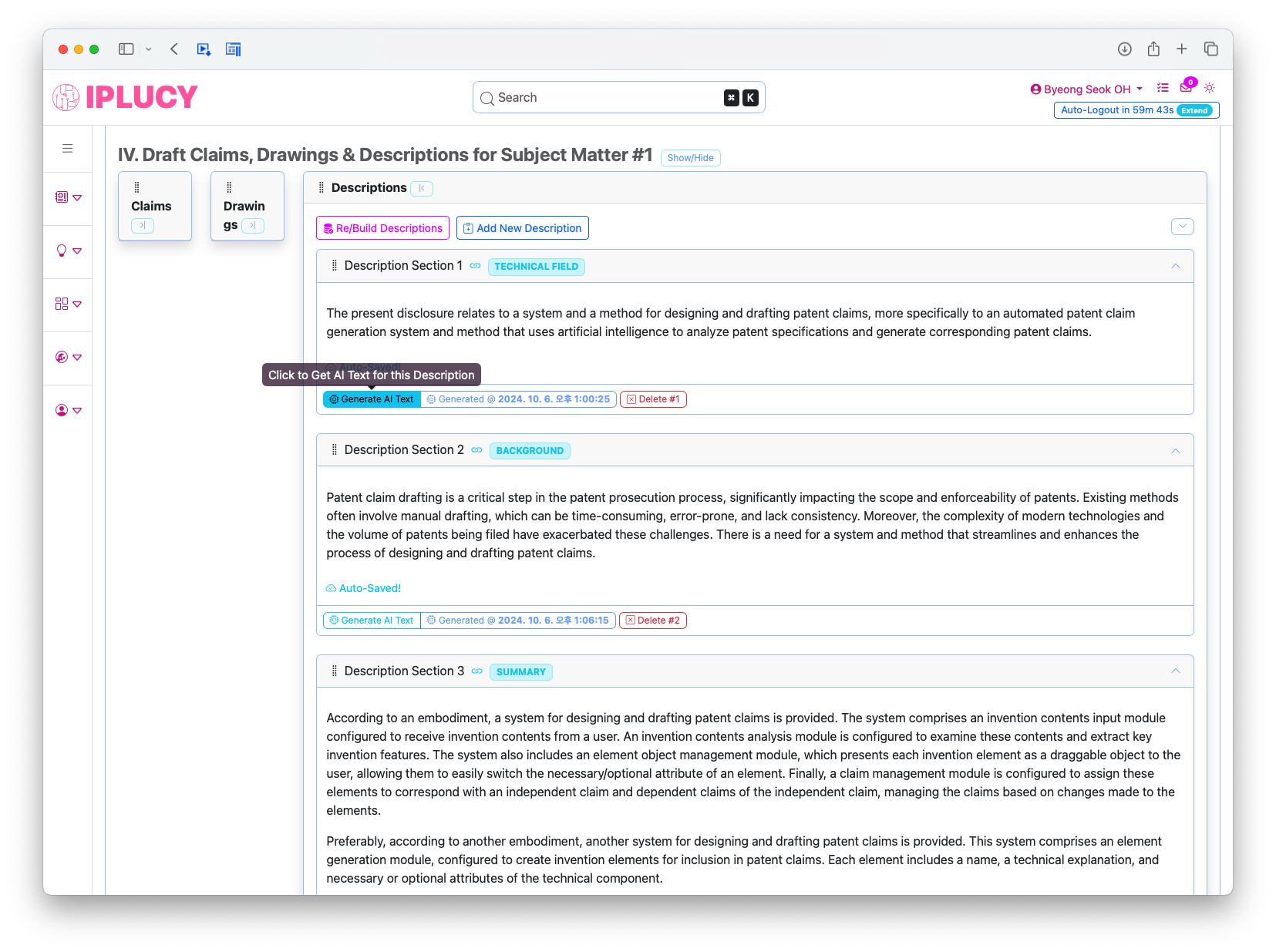
Rebuild Descriptions
As in the case of "Rebuild Claims or Drawings", when you added, removed and/or modified the elements, claims, drawing by editing their texts, hierarchy, etc., you need to reorganize the detailed descriptions. By clicking the "Rebuild Descriptions" button will "rebuild" the descriptions according to the modified contents. All the same rules explained above will be applied when rebuilding the descriptions.
Rebuild Descriptions Screen
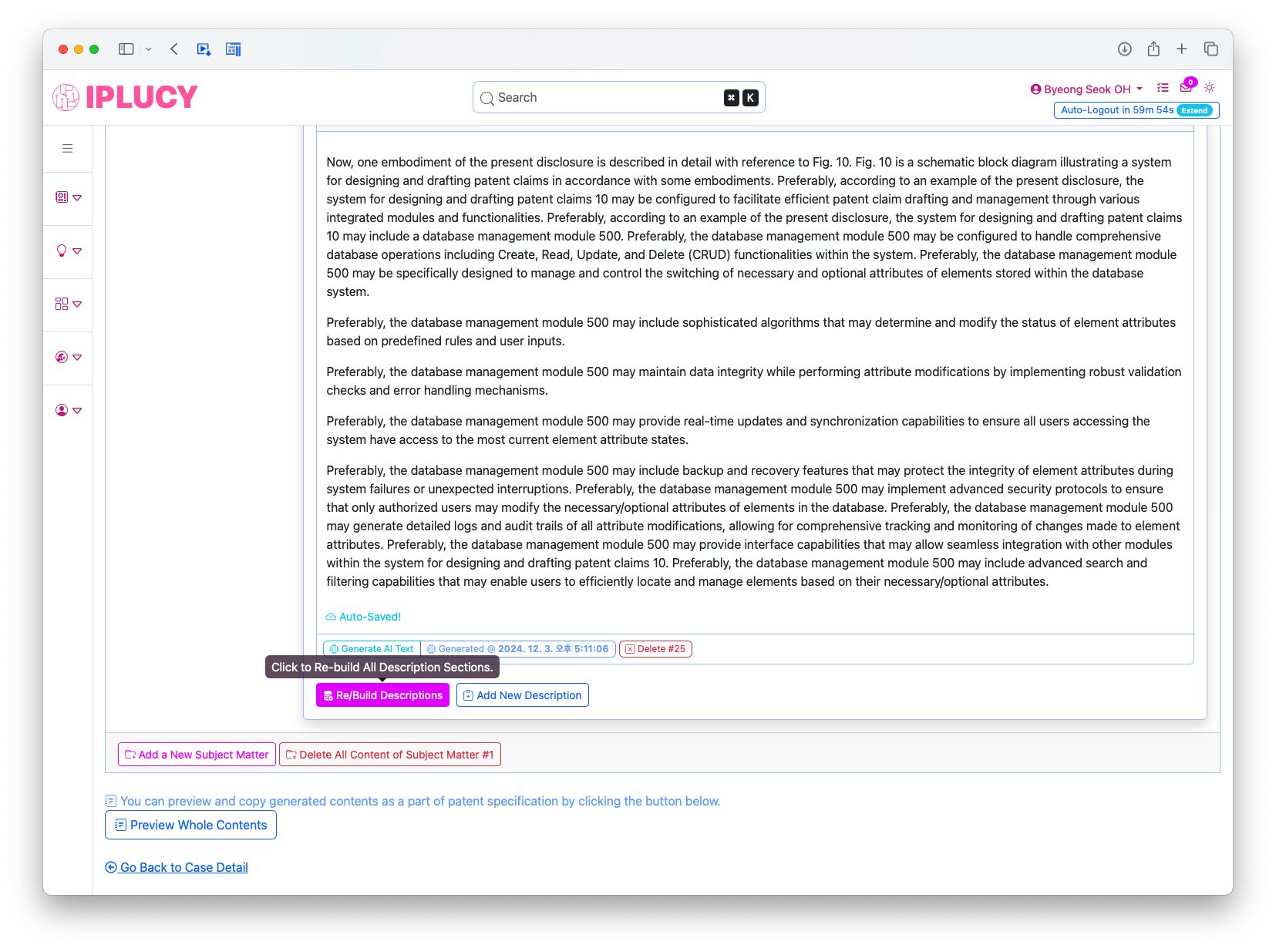
Step 9. Preview Whole Specification Click to Open/Close
Preview of Draft Specification
Clicking the "Preview Whole Contents" button at the bottom of the screen will display all the text of the generated claims.
Preview Button Screen
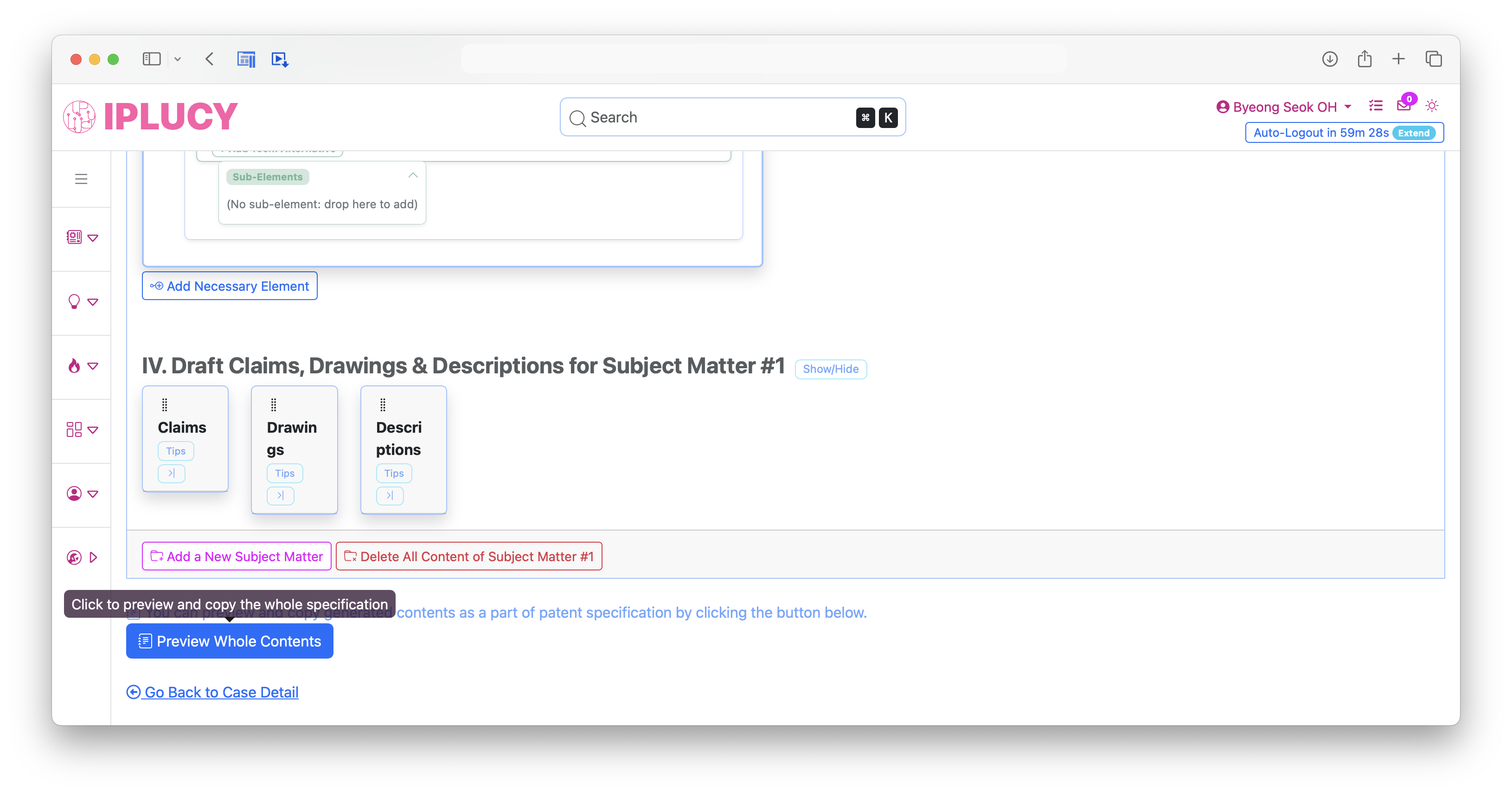
Clicking the "Copy Content" button at the bottom of the screen will copy the text to the clipboard and allow you to paste it directly into your word program.
Preview of Whole Contents Screen
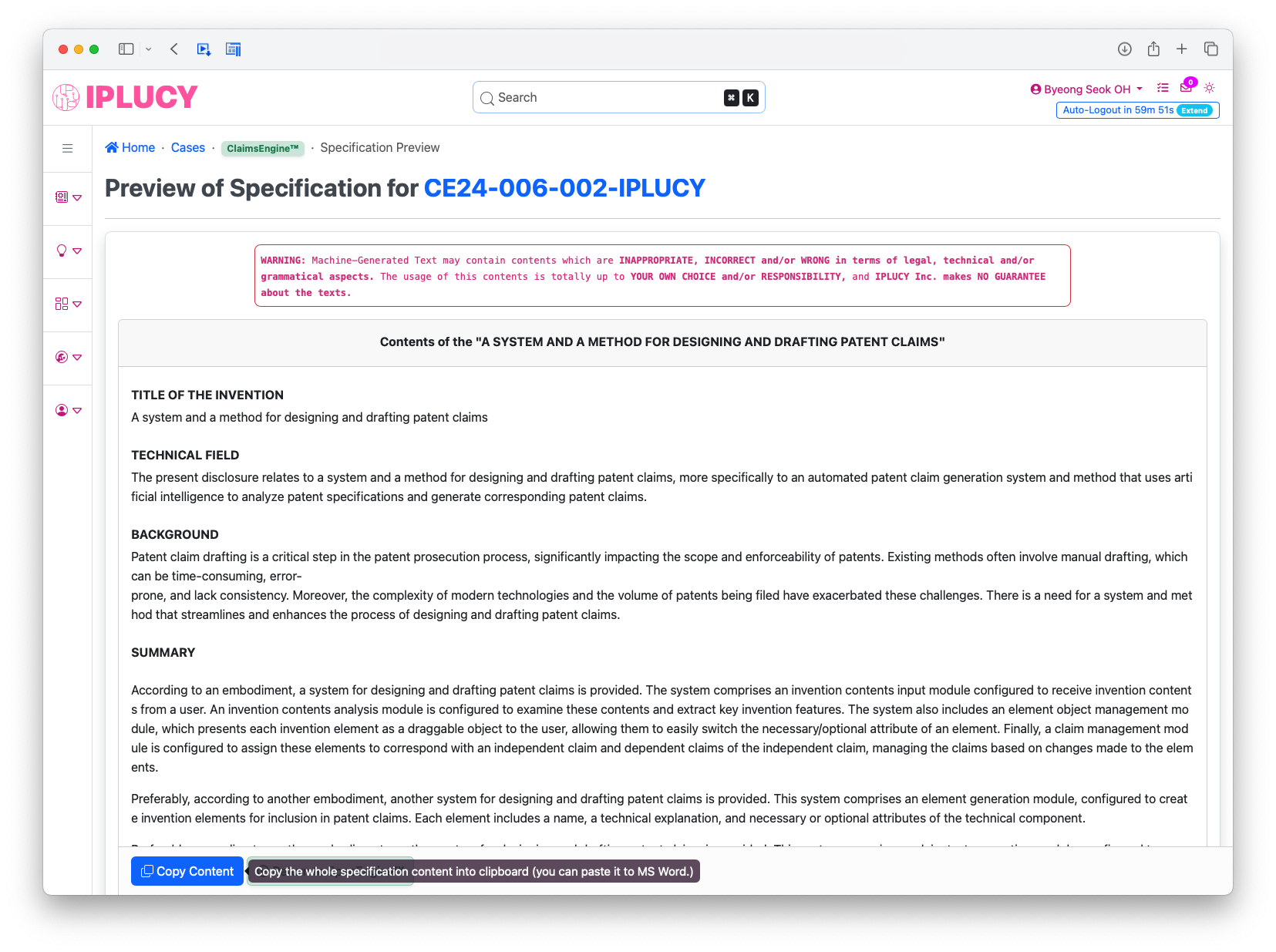
Step 10. Clone Specification Click to Open/Close
Clone Specification
"Clone Specifications" is the ability to create new specifications by replicating the entire content of an existing specification, which is very useful if you are to quickly work on consistent specifications for a series of similar inventions.
To execute "Clone Specification," click the "SpecEngine™ > All Specs" button on the menu of the left-hand side of the screen to navigate to the list of all generated specifications.
Find the existing specification card you want to replicate here and click the "Create Clone" button at the bottom of the card. A page will be shown where you can select the invention elements of the existing specification to be included in the new specification.
Clone Specification button screen
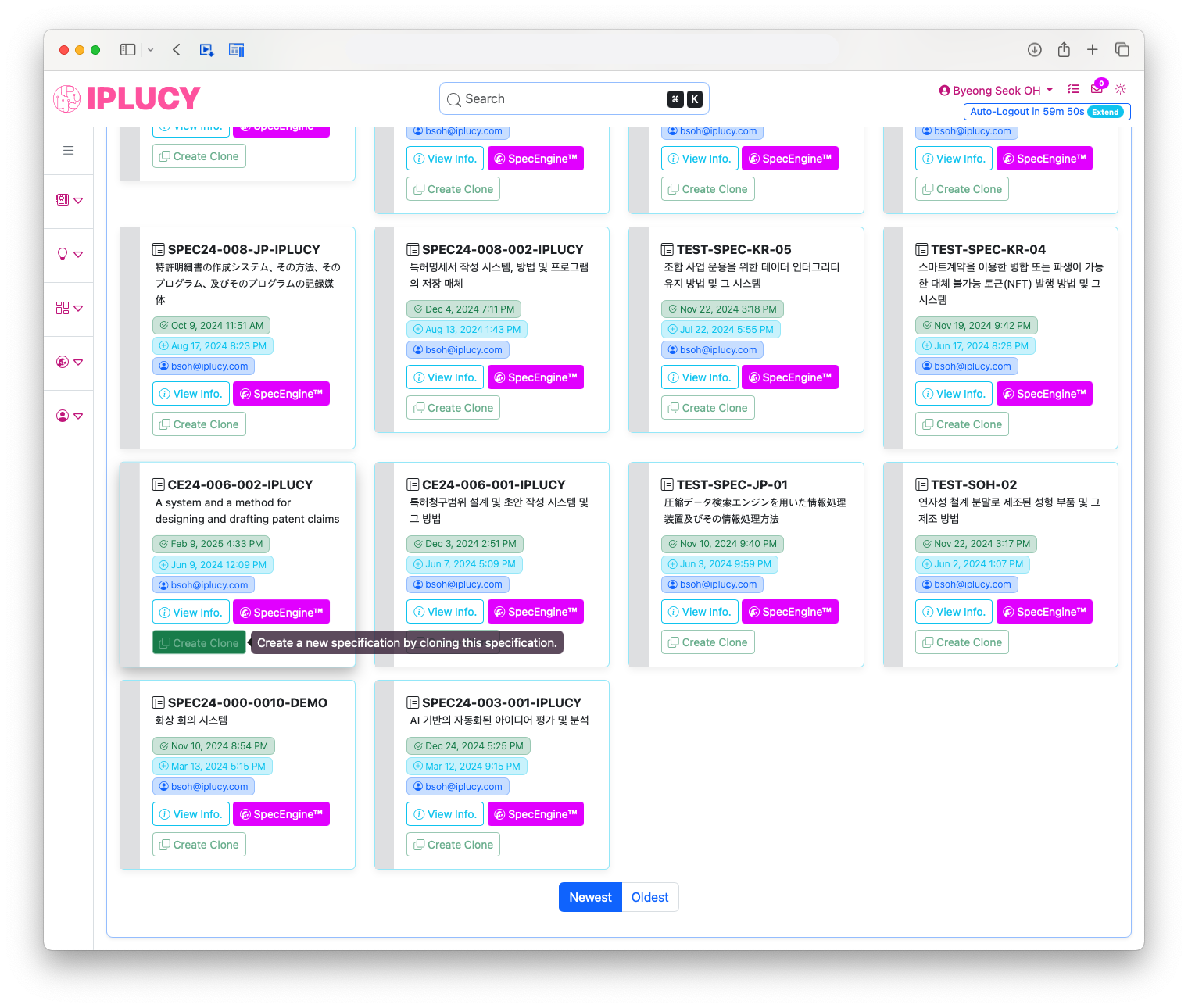
Enter the bibliographic information of the new specification, and select the invention elements of the existing specification to be included in the new specification below. Invention elements to be included in the new specification must be selected separately for each subject matter of the invention.
Claims, drawings, and detailed description sections related to the selected invention elements are all included in the new specification.
Click the "Creat!" button at the bottom of the screen to create a new specification, and navigate to the details screen of the new specification. You can repeat adding or editing new specification-specific invention elements or adding new subject matters as described above.
Existing contents to be cloned selection screen
